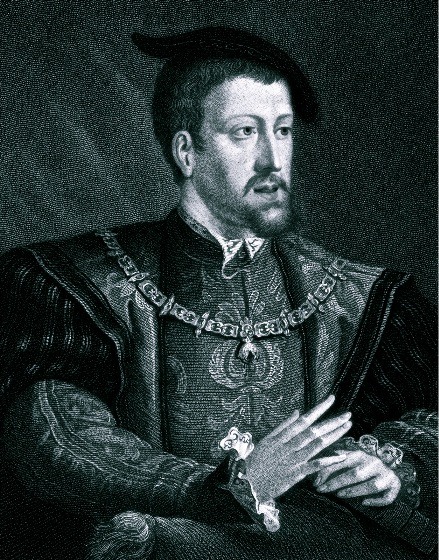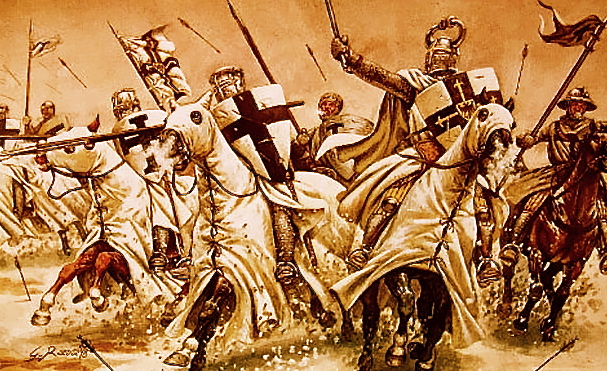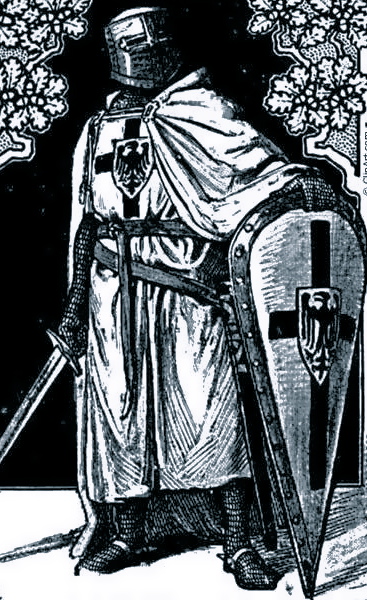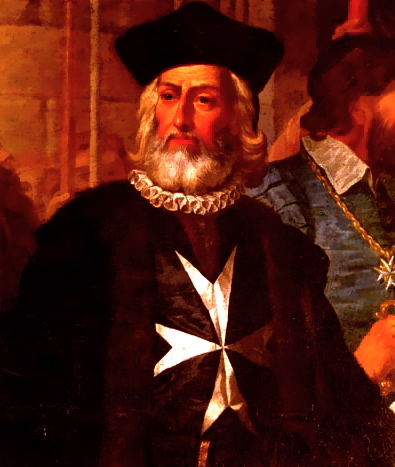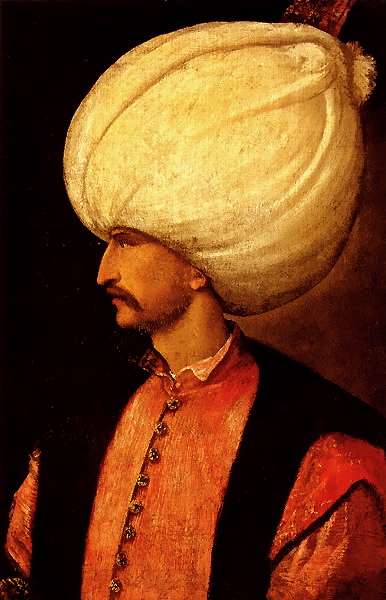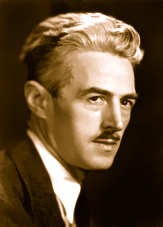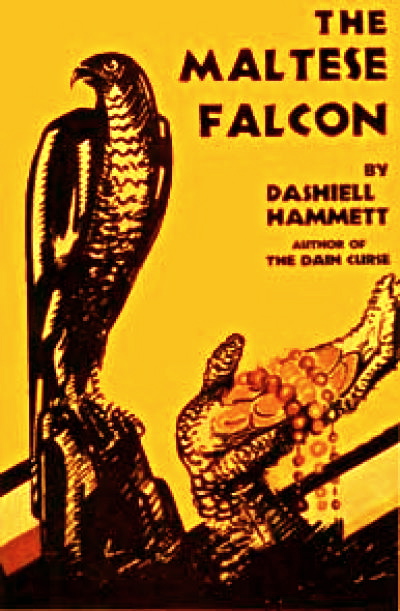|
The Knights Templar were a
Feared and Formidable Fighting Force
These Fanatical Warrior Monks offered Body and
Soul to their Religious Order
The Knights Templar Fought in Defense of Christianity
Templar Fortunes and History were closely associated with those of the
Crusades |
|
Acknowledging only the Pope as his
Superior - the Templar Grand Master was the equal of Kings
The Order Reigned Supreme for nearly two Centuries |
|
Mediterranean Region . . . time of the Crusades |
Knights Templar Crusaders |
|
Knights of the Temple of Solomon |
|
Stronghold of the Knights Templar
was on Jerusalem's Mount Moriah - called the Temple Mount
The Location of the Original Jewish Temple |
| 300 years after the crucifixion of Christ came the miraculous
discovery of the Holy Sepulcher by the Empress Helena, the mother of
Roman Emperor Constantine the Great. This set a tide of pilgrimage towards
Palestine and Jerusalem. This flow of spiritually inspired travelers
went on increasing in strength as Christianity gradually spread
throughout Europe. The ultimate goal for Christians was to visit
sacred places in accordance with their religion. Pilgrims traveled from
across Europe to Jerusalem just to fulfill their life long devotion. But
the road to the holy city was never without dangers.
This didnít stop the pilgrims from making the journey even after the
city fell under Islamic control. As the number of pilgrims increased,
bandits took advantage and harassed the devotees on the route to
Palestine. The greatest threat was the appearance of a group of Muslim
fanatics that massacred ďInfidelsĒ as one of their Islamic duties. |
|
Crypt of the Holy Sepulchre |
|
The Holiest Christian Site in the
World
The Church of the Holy Sepulchre Encompasses
Golgotha (the 'Place of the Skull') where Jesus was Crucified and the
Tomb (Sepulchre) where He was Buried |
|
The Vision of Constantine |
Church of the Holy Sepulchre |
"Knights of the Red Cross of Rome and
Constantine" formed the first Order of Christian Knighthood.
October 28th, 312 AD - An epic confrontation occurred eight or
nine miles north of Rome. The night before this historic battle between
Constantine and Augustus Maxentius, the vision of the 'Sign of the
Cross' appeared before Constantine in the Heavens above, and upon the
cross the inscription; "In hoc signo vinces". Constantine accepted
Christianity and the Cross of Christ and was thereafter undefeated in
his warfare.
December 25th, 312 AD - Successful in defeating his enemy,
Constantine the Great instituted a new Order of Knights, called the "Red
Cross of Rome and Constantine". The 'Red Cross' became a badge and was
worn on the right arm of each Knight or on his shield, this insignia
thereafter being the highest honor of Knighthood.Knights of the Holy Sepulchre - Instituted by Constantine, at the
prayer of his mother Helena, for the avowed purpose of protecting the
Holy Sepulchre, by defending it from the enemies of the Christian faith.
Only Knights of the Red Cross, by royal decree, were eligible for the
Order of the Holy Sepulchre.
In 326 - Constantine instituted the Order of the "Knights of the
Grand Cross", which he conferred on several of his generals and
ministers, as a special mark of merit and distinction.
In 337 - Death of Constantine the Great. The Popes of Rome
claimed now, and exercised, sovereign authority over the Orders
of Knighthood throughout Christendom, delegating to the Papal Nuncios
and Cardinal Princes, at the various Catholic Courts, the right to
nominate candidates to the Orders.
In 614 - the Persians took Jerusalem from the Romans. The Holy
City fell into the hands of the worshipers of fire. In 628, the Romans
recaptured Jerusalem. When the Muslim Prophet Muhammad died in June of
632, his successor, Abu Bakr, immediately launched a campaign of
conquest and colonization. He set in motion the most vigorous military
expedition since Roman times. The siege of Jerusalem in 637 by the Muslim
forces eventually gave Islam control over Jerusalem for a very long
time.
In 1048 - Founding of the the Order of the "Hospitalers of
St. John of Jerusalem" also referred as Knights of the Hospital
of St. John. Merchants from the ancient Marine Republic of Amalfi
obtained from the Caliph of Egypt the authorization to build a church,
convent and hospital in Jerusalem, to care for pilgrims of any religious
faith or race.
|
|
 |
|
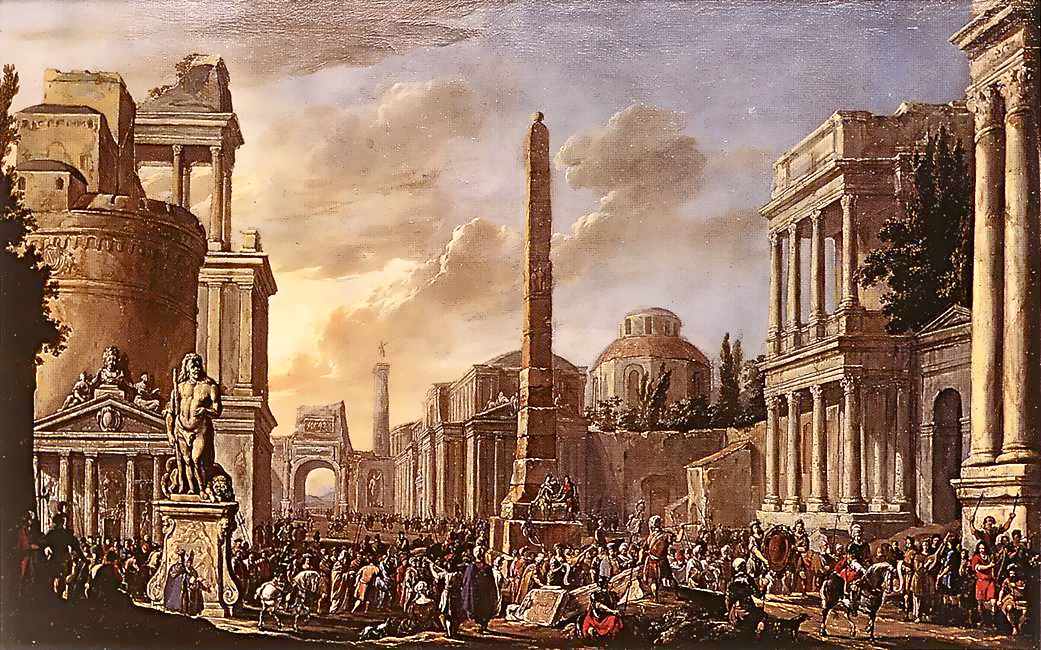 |
|
The Decadent City of Rome |
The Papacy had fallen to the lowest level in its history. "As
soiled," men said, "as the loincloth of Jeremiah".
Rome had infected the Church. Rome, where the night mist hung like a shroud and
beggars filled the alleys under the shadow of yellow marble palaces.
Rome, a meeting place of all peoples, a journey's end of Pilgrims;
turbulent, lawless and greedy.
In Rome, robbers haunted the empty cellars of the Forum, the nobles
waged feuds from hill to hill, and armed priests guarded the Lateran,
the residence of the Popes. Rome had degenerated into an open sore that
contaminated the Church within it!
In Rome, dogs and men-at-arms idled in the Monastery courtyards and many
nunneries were whore-infested. Wagons endlessly carried wine casks into
the city. "Not a priest could be found," said a chronicle of the time,
"who was not ignorant and given to women, and a buyer and seller of his
rights".
Some of the recent Popes had passed their lives in luxury that would not
have disgraced an Emperor. Some built palaces for their women. Young
boys were installed as abbots. Finally, a youthful Pope Benedict IX,
sold the Papacy for cash paid down, at the Latin Gate of the city, in
the year 1046.Then the Holy Roman Emperor, Henry III, used his power
to select new Popes. They were carefully chosen, especially from the
great Monastery of Cluny, from which pure blood was pulsing through the
diseased arteries of the churches.
The Holy Roman Emperors believed they held authority over men
and lands by 'Divine Right'. The Pope maintained that the church must be
free of the authority of the State. Two ideas were in conflict and two
determined men, Pope Gregory VII and Holy Roman Emperor Henry IV, forced
the issue to the last bitter extreme in 1076.
Pope Gregory VII excommunicated the Emperor, pronouncing him outcast from
the Church and the society of men, releasing his subjects from
allegiance to him. Then Gregory tried to bring about the election of a
new Emperor.
Whereupon, Emperor Henry IV assembled a church council that denounced
Pope Gregory VII and elected an 'Antipope' named Guibert. Henry IV then
marched on Rome, with spears flashing behind him. Open war raged and the
spears gained mastery. Pope Gregory VII called in dour Normans from the
south, and they added flames to slaughter in the city. Borne away by the
Normans, Pope Gregory VII died in exile by the sea. Definition
Antipope: Meaning Rival-pope" or "Counter-pope", is a person who
makes a controversial, yet substantially accepted, claim to be the
lawful Pope, and is elected in opposition to the Pope that is recognized
by the Roman Catholic Church.
Antipopes are typically those supported by a fairly significant faction
of cardinals, and in several cases it was hard to tell who was, in fact,
the lawful Pope, since the claim of each was widely accepted.
There have been several Antipopes throughout the history of the Roman
Catholic Church. The period when Antipopes were most numerous was during
the struggles between the Popes and the Holy Roman Emperors of the
eleventh and twelfth centuries. The Emperors frequently imposed their
own nominees, in order to further their own cause. |
|
Pope Urban II at Clermont
Extolling the First Crusade |
Henry IV
Holy Roman Emperor |
Peter the Hermit
Preaching the 1st Crusade |
Such was the situation when Urban II was chosen Pope by the 'Council
of the Cardinal Bishops' (Popes are still thusly chosen today). Urban came out of the silent cloisters of the
great Monastery at Cluny. In Rome, St. Peters Basilica and the Lateran
Palace were under the control of the Antipope. Pope Urban II therefore
traveled from place to place, becoming in fact, an apostolic wanderer.
Pope Urban, deprived of his Church, drifted through the lands bringing
back to God the people who had lost their faith.
So two Popes ruled! It grew clear to men that Pope Urban II, called by
the people the 'Golden Pope', was more just, while the Antipope Guibert
(chosen by the Emperor)
glittered with all honor and vast riches.
Pope Urban II planned a great enterprise. He devised to summon the
fighting men of Christendom to take up arms, not in any earthly quarrel,
but to march into Asia to recapture the Sepulchre of Christ. It would be
a pilgrimage and it would also be a war. Men of all nations would
enlist, and by so doing earn the right to absolution from their sins.
November 1095 - The Council of Clermont in Auvergne. Pope Urban
II addressed himself to all the nations represented at the Council, and
particularly to the French, who formed the majority, and which was his
nation by birth. The Golden Pope went outside to address the masses of people who
came to hear him, as he spoke from a high platform. |
|
Excerpted - Pope Urban II Speech at
Clermont |
"I speak to you who are present. I announce it to those who are
absent, and Christ ordains it."
"From the borders of Jerusalem and the city of Constantinople ominous
tidings have gone forth. An accursed race, emerging from the kingdom of
the Persians, a barbarous people, estranged from God, has invaded the
lands of the Christians in the East, and has depopulated them by fire
and steel and ravage. These invaders are Turks and Arabs."
"The Empire of Constantinople is now mutilated and has lost so much land
that a voyager could not cross the dismembered part in two months. Until
now, this Empire has been our rampart. It is in dire straits."
"These Turks have lead away many Christians, captives, to their own
country. They have torn down the churches of God everywhere, or used
them for their own rites. What more shall I say to you? Listen. The
invaders befoul the altars with the filth out of their bodies, they
circumcise Christians and pour the blood of the circumcision upon the
altars or into the baptismal fonts. They stable their horses in these
churches, which are now withdrawn from the service of God. Yea, the
churches are served, but not by holy men, for only the Turks may use
them."
"Even now the Turks are torturing Christians. They are binding them and
filling them with arrows, or making then kneel, bending their heads, to
try if their swordsmen can cut through their necks with a single blow of
a naked sword. What shall I say of the ravishing of the women? To speak
of this is worse than to be silent. You, in France, have heard the
murmur of agony on the border of Spain. The time may come when you will
see your wives violated and your children driven before you as slaves,
out of the land."
"Think of those who have crossed the sea as Pilgrims. If they carried
wealth, they were forced to pay all toll and tribute every day, at the
gates of cities and at the entrance to the churches. If they were
accused of anything, they were forced to buy their freedom again. And
those who had no money, trusting in poverty, what of them? They were
searched, and even the calluses were cut from their bare heels to see if
they had sewed something there. They were given Scammony to drink, until
they vomited or burst their bowels, lest they had swallowed coins. More,
their bowels were cut open with a sword, their intestines pulled forth
and slit, so that what was hidden there could be disclosed."
"Set forth then, upon the way to the Holy Sepulchre. Wrest that land
from the evil race and keep it for yourself. That land which floweth
with milk and honey . . . Jerusalem."
"Fear not torture, for therein lies the crown of martyrdom. The way is
short, the struggle brief, the reward everlasting. Yea, I speak now with
the voice of the Prophet, 'Arm Thyself, O Mighty One'! Take up your
arms, valiant sons, and go. Better fall in battle than live to see the
sorrow of your people and the desecration of your holy places."
"Go, with One who lacks not the Power greater than wealth to aid you.
Lo, I see before you, leading you to His war, the standard bearer who is
invisible . . . Christ." |
|
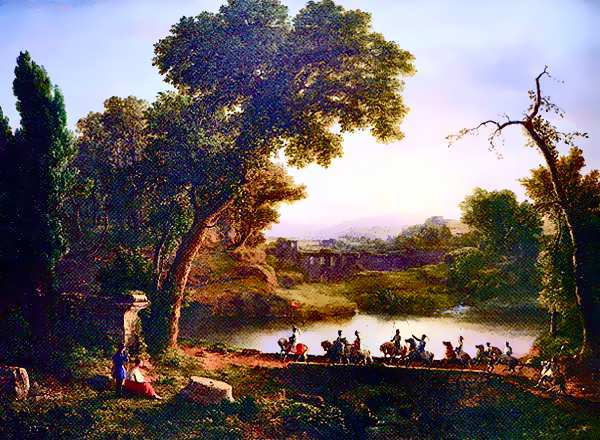 |
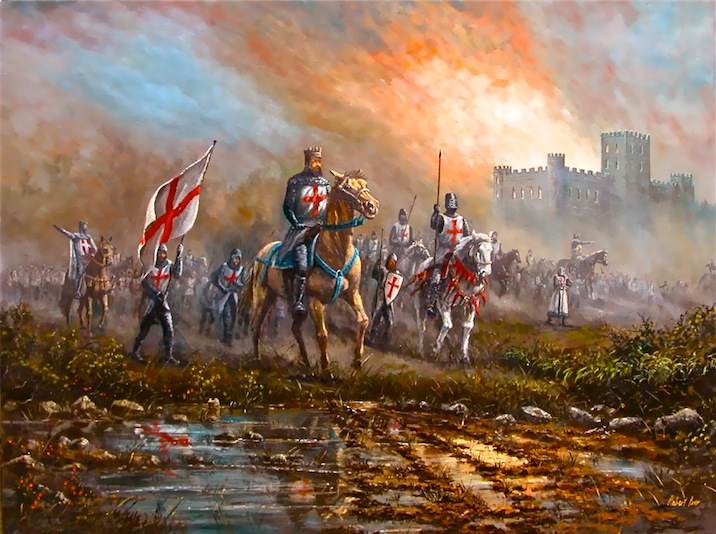 |
|
Contingents of European Crusader Knights - Enroute
to Jerusalem |
The Golden Pope exalted them, "It is Christ himself who
issues from His tomb, and presents to you His Cross. It will be the sign
raised among nations, which is to gather together again the dispersed
Children of Israel."
"Wear it upon your shoulders and upon your breasts. Let it shine upon
your arms and upon your standards. It will be to you the surety of
victory or the palm of martyrdom. It will unceasingly remind you that
Christ died for you, and that it is your duty to die for Him."
The Monk, Ordericus Vitalis wrote in his cell by candlelight
one night . . .
"An astonishing desire to go to Jerusalem, or to aid those who were
going, animated equally the rich and the poor, men and women, monks and
peasants. Husbands were ready to leave their loved wives, these in turn
longed ardently to leave their children (although with tears) and all
their cherished belongings, and to follow their husbands on the
expedition."
"Lands of great value until now, were sold at a vile price, and everyone
bought arms to go to avenge God against the infidels. Thieves, pirates,
various criminals, were touched by grace, and came out of the abyss of
their misery, renouncing their crimes and setting out for the far-off
land to expiate them. The wise Pope encouraged to go to war all those
who were in condition to carry arms against infidels. He accorded them,
by virtue of his great power, absolution from their faults after the
hour when they took the cross." |
Peter the Hermit rode around on his gray mule with his bare
feet hanging in the grass. He wore a gray woolen shirt with a hood
pulled over his head and a sleeveless monk's robe flapping around his
ankles. Peter spoke to the crowds with a fiery tongue, proclaiming the
Crusade. People thronged him, carrying lighted candles, when he halted
near a church in the evening.
A Knight was his companion, and a Teutonic priest, and a mass of
disciples followed him. So greatly did they reverence their leader that
they cherished hairs cut from the mule Peter rode. He became the
shepherd of a growing flock all resolved to follow him to Jerusalem.
Peter soon found himself commander of an army of over fifteen thousand.
It has been called the 'Peasants Crusade', but it was really an
expedition of the people. A few men of gentle blood rode in the throng
with their servants, and some scores of men-at-arms trudged afoot.
Beribboned women of the Paris streets sat on the baggage wagons, while
ragged beggars trotted beside them, the masterless and penniless alley
folk. Some, who strode along now, had been 'Testatori' (actor
beggar cripples who haunted the steps of Notre Dame Cathedral). In the
rabble bands came mock-monks and weepers, halegrins and fit-throwers,
hymn-chanters and cut-purses. Somewhere in this human morass was the
'Tafur', the King of Thieves. But the bulk of the
motley host was made up of bearded Rhinelanders, and stoop shouldered
ploughmen from the north of France.
"All the common folk," a chronicler explains, "the clean as well as the
filthy, and adulterers, man killers, perjurers, and the thieves. Nay,
also women and those who had turned penitent." |
|
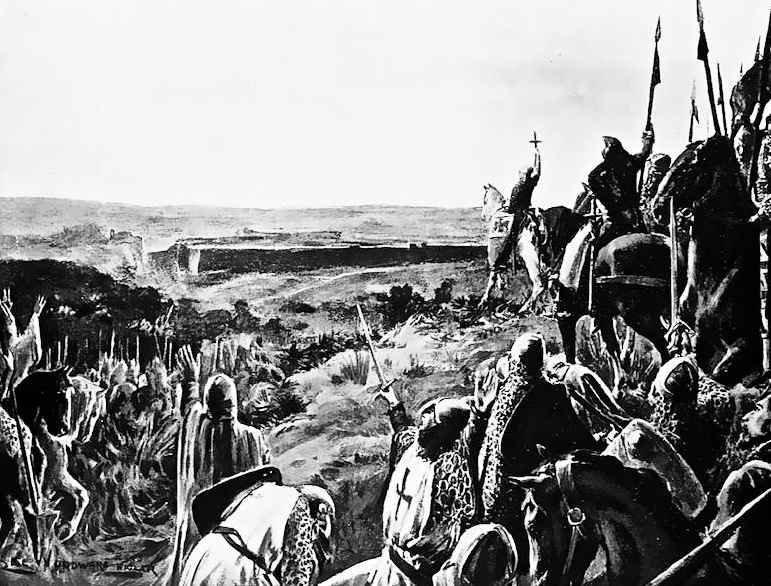 |
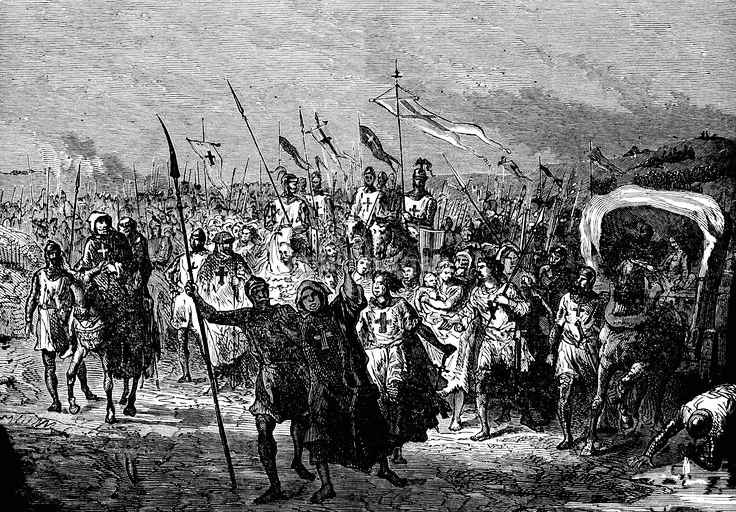 |
|
Crusaders First Sight of Jerusalem
From the Hill of Emmaus . . . circa June 10th, 1099 |
First Crusade
Crusader Army of Nobles, Ecclesiastics and Peasants |
|
Crusaders Outside of Jerusalem |
| During the First Crusade (1096-1099) . . . Jerusalem was Captured -
After 460 years of Muslim rule, Jerusalem came under Christian control.
The crusaders established a "Kingdom called Outremer" that stretched
from Palestine to Antioch and made Jerusalem its capital city.
When the crusaders conquered Jerusalem their
immediate concern was to restore and beautify the Holy Sepulchre, and
work began very shortly after the Christian victory. It was completed by
the 50th anniversary of the Christian takeover of Jerusalem. |
|
Crusaders Conquer Jerusalem - 1st
Crusade |
|
The Christians had established control over Outremer and the
procession of Christian pilgrims traveling Eastward to visit the "Holy Land"
greatly enlarged. However, though
the city of Jerusalem was under relatively secure control, the rest of Outremer
was not. Bandits abounded, and pilgrims were routinely slaughtered,
sometimes by the hundreds, as they attempted to make the journey from
the coastline at Jaffa into the interior.
Always the lofty mountains bordering the sea-coast of Outremer were
infested by bold and warlike bands of fugitive Moslems, who maintained
themselves in various impregnable castles and strongholds, from whence
they issued forth upon the high-roads, cut off the communication between
Jerusalem and the sea-ports, and revenged themselves for the loss of
their habitations and property by the indiscriminate pillage of all
travelers. The French Knight Hugues de Payens
proposed the creation of a monastic/chivalric order for the
protection of these pilgrims. |
|
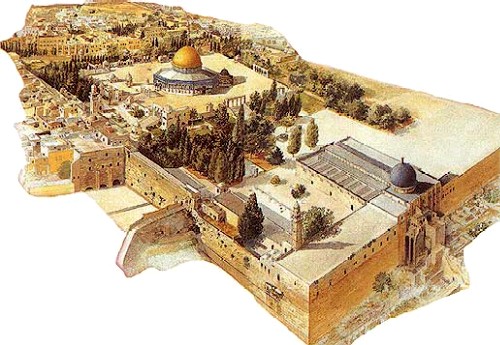 |
|
Mount Moriah in Jerusalem |
| Many Templars were of Palestinian birth, spoke perfect Arabic, and
were familiar with many religious sects, cults, and magical doctrines of
the East,
including the secrets of the Persian Hashishians, which are the source
of the English word "Assassins". For instance, the Templar Grand Master Philip of
Nablus (1167 AD) was a Syrian.
The Assassins, it might be mentioned,
eventually became what is known today as the Ismaili sect of Islam.
Their head is the Aga Khan, and their followers today reside largely in
Pakistan and India. The Aga Khan, a hereditary leadership
descended from Mohammed, maintains residences in both London and Bombay.
The father of todayís Aga Khan was married to Hollywood actress Rita
Hayworth. |
|
At first the Knights had no Church,
no Fortress, and no regular Quarters
They called themselves the "Poor Fellow Soldiers of Christ" |
In 1118 - Nineteen years after the conquest of Jerusalem by
the Crusaders, the 'Poor Fellow-Soldiers of Christ' had rendered such
good and acceptable service to the Christians, Baldwin II, King of
Jerusalem, granted them a place of habitation within the sacred
enclosure of the Temple on Mount Moriah. The Temple Mount had a
mystique, because it was above what was believed to be the ruins of the
Temple of Solomon. This bestowal effectively changed their name to
Knights of the Temple of Solomon (Templars). The Templar philosophy was
modeled after the Benedictine code, especially as understood and
implemented by the Cistercians.
From the very beginning, the 'Knights of the Temple' had a military
character, and their purpose was to protect the pilgrims on their way to
Jerusalem. Led by the Order's founder Hugues de Payens, the Knights
Templar forces waged a series of military expeditions aimed at defeating
Muslims in the Holy Land, then called Outremer.In 1128 - Pope
Honorius II granted a 'Papal Sanction' to the
military/religious order known as the Knights Templar, declaring it to
be an 'Army of God'. Endorsed by the Roman Catholic Church, the
Knights Templar grew rapidly
in membership and power. |
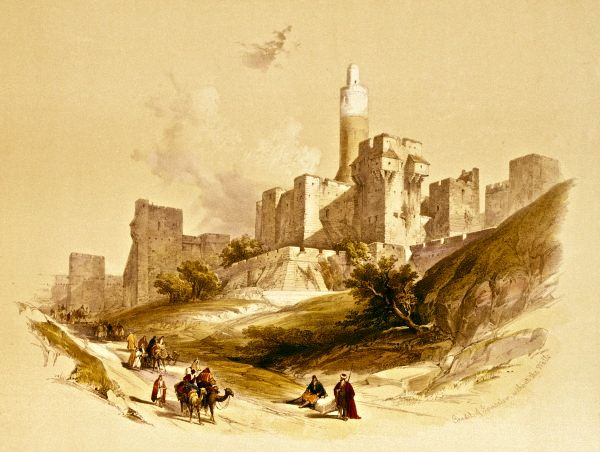 |
|
"In Praise of the New Knighthood" |
Jerusalem |
| Patron Saint of the Knights Templar - St. Bernard
the
Abbot of the
Cistercian monastery of Clairvaux, theologian, and preacher of the
great crusade. In 1128, Saint Bernard published a pro-Templar tract
entitled 'In Praise of the New Knighthood'. Andrť de Montbard, one of
the nine founding members of the Knights Templar, was the uncle of
Bernard of Clairvaux. This famous tretise elevated the 'Order of the
Temple' above all others of the day, including the Knights Hospitallers.
This manuscript established the image of the Templars as a fierce
spiritual militia for Christ. Saint Bernard regarded the Templars as an
entirely new species of knighthood, previously unknown in the world,
pursing a double conflict against both flesh and blood, and the
invisible forces of evil.
The Council of Troyes - The Templar Order was officially
endorsed by the Church. With this formal blessing, the Templars became
highly regarded throughout Christendom, receiving money, land,
businesses, and noble-born sons from families who were eager to help
with the fight in the Holy Land.
|
|
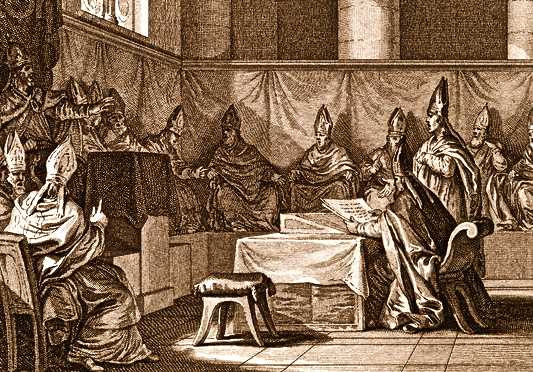 |
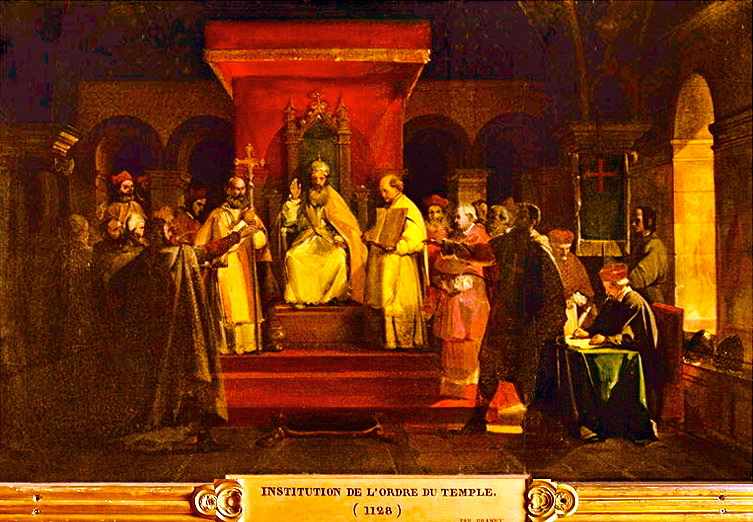 |
|
Council of Troyes . . . circa 1128 |
Pope Honorius II - Papal Sanction Recognition of
Templars |
| The adoption of the Templar Order by St. Bernard was a key event in
the transformation of the 'Poor Knights of Christ' into the financial
and military powerhouse the Templars attained. St. Bernard perceived a
means of channeling the feudal nobility's surplus energy, which would
convert 'criminals and godless, robbers, murderers and adulterers'. St.
Bernard urged young men to take up the Templar sword, comparing the
Templar's holy way of life, so pleasing to God, to the degenerate ways
of the secular knights, whose lives were dedicated to vanity, adultery,
looting, and stealing, with many sins to atone for. The dedication to
Christ, to a life of chastity and prayer, to a life that might be
sacrificed in battle against unbelievers, was enough penance to atone
for any sin or any number of sins. |
|
Saint Bernard |
Frenchman Hugues de Payens |
King Baldwin II of Jerusalem |
| "The warriors are gentler than lambs and fiercer than lions, wedding
the mildness of the monk with the valour of the knight, so that it is
difficult to decide which to call them: men who adorn the Temple of
Solomon with weapons instead of gems, with shields instead of crowns of
gold, with saddles and bridles instead of candelabra: eager for victory
-- not fame; for battle not for pomp; who abhor wasteful speech,
unnecessary action, unmeasured laughter, gossip and chatter, as they
despise all vain things." - St Bernard Attire of the
Knights of the Temple of Solomon was white, meant to remind them "to
commend themselves to their Creator by a pure life". Soon, a red cross
was added, signifying the blood to be shed for the defense of the faith.
Unlike other religious/military Orders, the Knights Templar wore long
beards.
Knights were required to be of knightly descent. They were equipped as
heavy cavalry, with three or four horses, and one or two squires.
Squires were generally not members of the Templar Order, but were
instead outsiders who were hired for a set period of time. Knights wore
white robes with a red cross, and a white mantle.
Beneath the knights in the Templar Order and drawn from lower social
strata were the sergeants. They were either equipped as light cavalry
with a single horse, or served in other ways such as administering the
property of the Templar Order or performing menial tasks and trades.
Sergeants wore a black tunic with a red cross on front and back, and a
black or brown mantle.
In 1129 - First Templar Grand Master, Hugues de Payens, led a company of
300 knights, recruited from the noblest houses of Europe, to accompany a
huge train of pilgrims to Jerusalem. During this time the Templars
formed part of a contingent which, allied with the Assassins of Persia,
tried to take the important city of Damascus.
In 1135 - "A Templar Knight is truly a fearless knight, and
secure on every side, for his soul is protected by the armor of faith,
just as his body is protected by the armor of steel. He is thus
doubly-armed, and need fear neither demons nor men." -
St. Bernard
In 1139 - Pope Innocent II's papal bull, Omne Datum Optimum,
exempted the Order from obedience to local laws. This ruling meant that
the Templars could pass freely through all borders, were not required to
pay any taxes, and were exempt from all authority except that of the
Pope
|
|
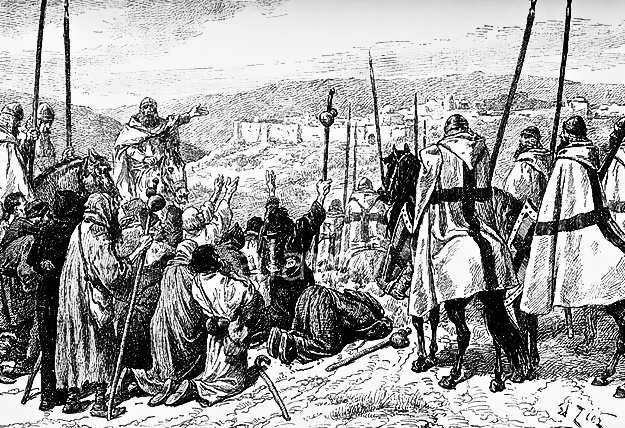 |
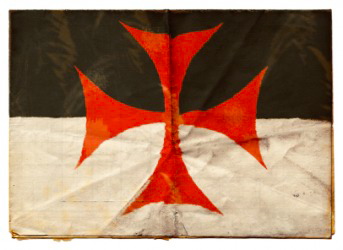
Templar Cross on Flag The
'Cross Patee' (above) |
|
Knights Templar - Escorting Pilgrims within sight
of the Walls of Jerusalem |
|
| In 1145 - At Pope Eugene III's command, St.
Bernard praised
the Second Crusade. His preaching in France, Germany, and the Low
Countries exerted a powerful influence on nobles, landed gentry, and
commoners alike.
Huge crowds gathered, drawn by the prospect of hearing St. Bernard
preach the crusade. So many had arrived that Bernard had to
deliver his sermon from a specially constructed platform on the
outskirts of the town. Bernardís words found a receptive audience. As soon
as he had finished speaking, King Louis of France was the first to
pledge allegiance. Of all of those who vowed to journey to the East that
day, many were the sons and grandsons of the original crusaders, to whom
maintaining family honor was at least as important as liberating Edessa
in Outremer.
Vast armies were soon on the road toward Jerusalem. In
his last years, St. Bernard rose from his sickbed and went into the
Rhineland to defend the Jews against savage persecution.
In 1146 - Pope Eugene III decreed that only the Knights
Templar could wear a special red cross with blunt wedge-shaped arms
called the 'Cross Patee' on the left breasts of their white robes, so
that they could be quickly recognized at any time by Christians and by
other Templars on the field of battle. The white robes with red crosses
became their required dress. The Templar Knights fought bravely in the
Middle East, and were highly respected by their Moslem counterparts for
their strategy and bravery. (1147 to 1149) 2nd Crusade - The Knights Templar fought their first full scale battle during the
Second Crusade. Their usual duties involved guarding the
pilgrims routes and accosting Muslim bandits along the highways into
Jerusalem. A totally dedicated fighting force, the Templars were
renowned for never leaving the battlefield while their black and white
piebald standard, called the Beauseant, was raised. Later in 1241, at the
Danube river, the Knights Templars would die to the last man on the battlefield,
against the invading forces of the Mongol Empire. |
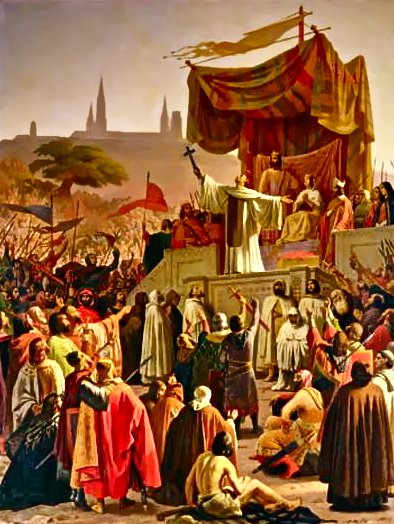
Saint Bernard - Expounding 2nd Crusade |
|
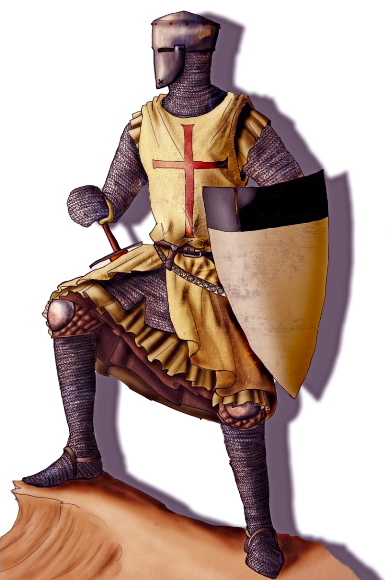 |
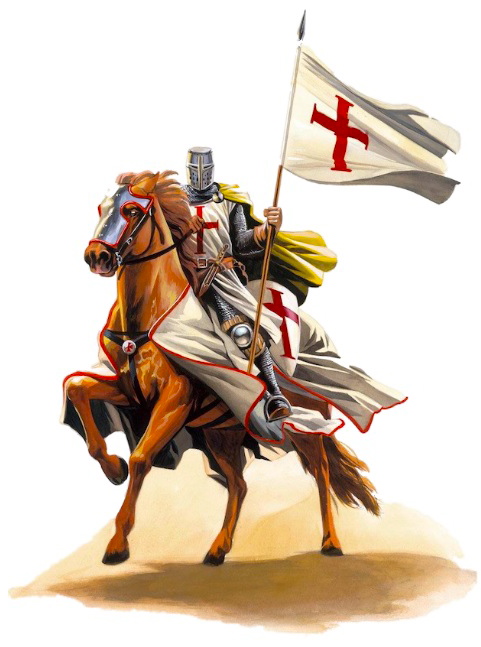 |
| For the pilgrims visiting Outremer, to whom the Knights of the
Temple provided some protection, such a long journey certainly required
an adequate supply of cash, but carrying that much coin around was a bad
idea, as bandits and highwaymen were common at the time. |
|
Order of the Knights Templar
The "World's 1st International Bank" |
| In 1150 - The Templars began generating "International Letters of
Credit" for
pilgrims journeying to Jerusalem. Pilgrims deposited their valuables
with a local Templar Preceptory before embarking, received an encrypted
document indicating the value of their deposit, then used that document
upon arrival to claim their funds. This innovative arrangement may have
been the first formal system to support the use of what was essentially
paper money backed by gold. It also improved the safety of pilgrims by
making them less attractive targets for thieves. Not to mention it contributed
to the Templar coffers, especially since a substantial proportion of
deposits would never be reclaimed. The Order of the Temple owned great
tracts of land, donated by the royal European families, and upon which were built fortresses. These connected as
outposts, all the way along the pilgrim road to Outremer. The Templar
system of paper money among their many connecting castles was ingenious.
Pilgrims would simply safeguard their gold in a Templar depository near
their home town and be issued a International Letters of Credit, which tabulated the holdings
and recorded the history of withdrawals. This international monetary
certificate could be presented at Templar castle strongholds anywhere in
the world, thus eliminating the need to carry excessive gold and silver.
When a nobleman would join their ranks, he would surrender his castle
and property to the Knights who would use revenues generated from the
property to purchase weapons, war-horses, armor and other military
supplies.
Although initially they had started providing banking facilities just
for pilgrims, within a short time, they had gained a broad range of
interested customers. It was far safer to deposit money with the
Templars than to keep it almost anywhere else. The Knights kept
scrupulous accounts, enabling them to run an effective, reliable and
accountable service. The Templars quickly expanded their financial
services to include accounts, safe deposit boxes (documents, gold,
jewelry, etc.), loans, credit and pensions. The Templars also acted as
tax collectors and receivers. The Templars eventually began lending
money to European Rulers.
The Templars have been described as taking crown jewels and indeed
entire kingdoms as mortgage for loans, and they maintained major
branches in France, Portugal, England, Aragon, Hungary and various
Mid-Eastern capitals. The group controlled as many as 9,000 estates, and
left behind hundreds of buildings great and small. |
|
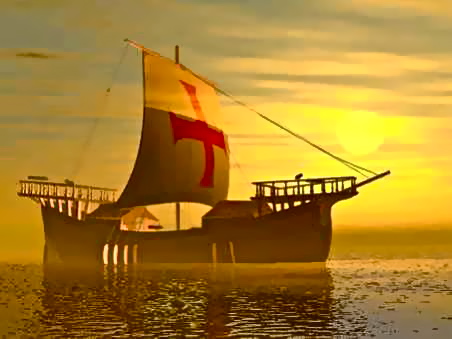 |
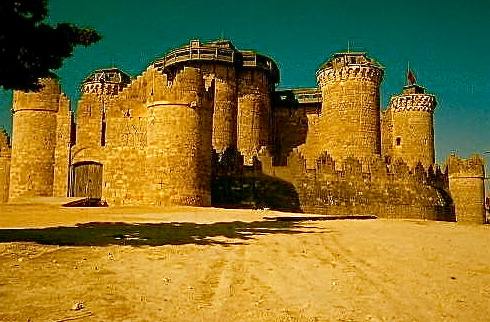 |
|
Templars had Naval Forces |
Ponferrada Templar Castle |
| The Knights Templar bought and managed farms and vineyards. They
built churches and castles. They were involved in manufacturing, import
and export. They had their own fleet of ships and at one point they even
owned the entire island of Cyprus.
Although the primary mission of the Templar Order was military,
relatively few members were combatants. The others acted in support
positions to assist the knights and to manage the financial
infrastructure. The Templar Order, though its members were sworn to
individual poverty, was given control of wealth beyond direct donations.
A nobleman who was interested in participating in the Crusades might
place all his assets under Templar management while he was away. |
|
Templar Donan Castle - Scotland |
|
Church of the Knights Templars - Luz France |
Almourol Castle - Portugal |
|
England's Rochester Castle . . . circa 1828 |
Tomar Castle - Portugal |
|
Battle Weary Knight |
Templars in Council |
|
Salah al-Din is known in the West as
'Saladin'
Derived from the Inability of Europeans to
Pronounce an Easterners Name |
|
An Old Proverb in Islam - "Only a hand that can
wield a sword may hold the scepter" |
| Born into a Kurdish, Sunni military family, Salah al-Din
(1138Ė1193) rose rapidly within Moslem society as a subordinate to the
Persian military leader Nur al-Din. He eventually became head of the
military expeditionary forces. In 1168 - The Caliph of Cairo
was apart from orthodox Islam. A schismatic, his adherents were devotees
of Fatima, the daughter of the Prophet Muhammad. He wore white instead
of traditional black and his congregation believed passionately in the
coming of El Mahdi, the "Guided One", who would become a second
Muhammad.
The Fatimid Caliph lived in guarded seclusion. Sudani swordsmen filled
the corridors of the 'Great Palace' in Cairo, Egypt. They paced the
antechambers and were at the marble fountains where peacocks strutted
and parrots screamed. In dark whispers insiders related stories of a
Caliph who had poisoned his son and a Wazir who had been cut to pieces
by the palace women.
The Caliph ruled Egypt only in name. The real power rested in the hand
of his Wazir, or minister. The Caliph had become a figurehead, the Wazir
a dictator.
The Knights of Jerusalem and the Mamluks of Damascus had both tasted the
honey pots of the Great Palace, and had seen with their own eyes the
weakness of the men of Cairo.
Amalric, King of Jerusalem was an aggressive fighter. He felt the
capture of Cairo would bring final triumph to the Crusaders. He marched
to the conquest of Cairo. But the Moslem army of Nur ad-Din also marched
towards Cairo. King Amalric failed to surprise Cairo and was forced to
withdraw upon the arrival of the Moslem forces under the command of
Shirkuh.
Shirkuh rode triumphantly through the gates of Cairo and boldly claimed
the reward of a rescuer. The old dictator was put to death and Shirkuh
was duly declared Wazir of Egypt. Shirkuh then died in the moment of the
triumph, poisoned like the Caliph's son. |
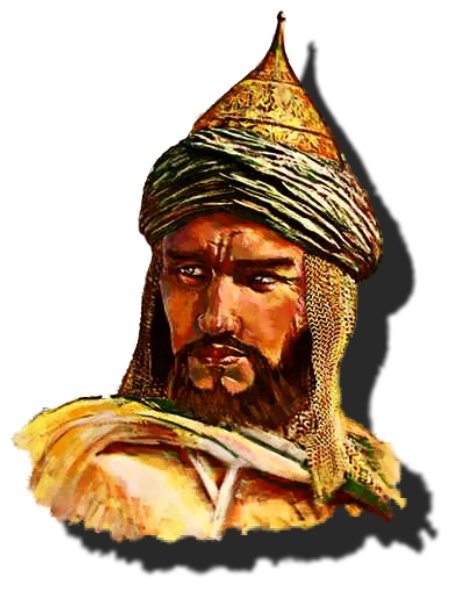 |
His sudden, unexpected death left Nur ad-Din's army without a
leader, and the Caliph of Cairo without anything to protect him from the
army. The situation was precarious and the Amirs of the army agreed with
the Caliph, a new Wazir should be chosen at once.
The Amirs debated among themselves and finally named Shirkuh's nephew,
in order to win the loyalty of Shirkuh's Mamluks. He was a young officer
who was a favorite. The Caliph agreed at once, seeing in the officer a
man too young to be experienced, thereby an easier man to deal with than
Shirkuh.
So the Caliph sent a new robe of honor to the army camp, with an escort
of Kadis to salute the hitherto obscure officer and bestow upon him his
name title - El Malik en-Nasr . . . the "Conquering King".
The officer chosen was Salah al-Din.Salah al-Din now discovered
himself to be at once the Wazir of a schismatic Caliphate and yet the
general of the orthodox army of Damascus.
Salah al-Din planned the Jihad early on. He knew only in the Jihad, the
"Holy War", could he unite the factions of the Near East. Turkoman, Kurd
and Arab would follow the standards to war against the unbelievers. The
Atabegs of the North, the Shaikhs of the desert clans, and the Amirs of
Egypt, would ride to such a summons, united against a common foe. |
|
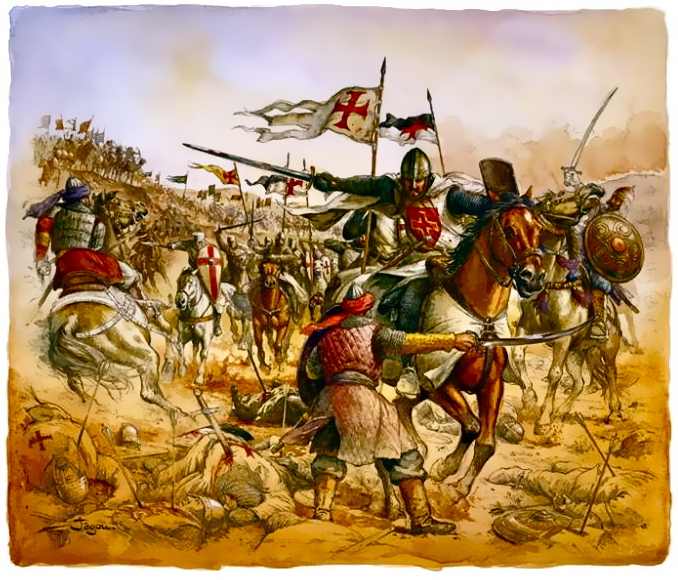 |
| In 1177 - Templars were often the advance force in key battles of the
Crusades, as the heavily armored knights on their warhorses would set
out to charge at the enemy, in an attempt to break opposition lines. One
of their most famous victories was during the Battle of Montgisard, where some 500 Templar Knights helped to defeat Salah al
Din's army of more than 26,000 soldiers. In 1184 - Reginald of
Kerak had dared the unthinkable, and was recently returned from a raid
on the holy city of Mecca, to destroy the sanctuary of Islam. But he had
been turned back by Moslem forces. Now Reginald was secluded in his
fortress, called the 'Stone of the Desert', which was positioned at the
point of greatest danger from Moslem invasion, on the frontier of the
Holy Land. The 'Stone' was the furthest bastion of Christianity.
It came to pass that Reginald was in the process of a wedding feast for
a noble couple. Salah al-Din came up unseen during the feasting,
bursting on the scene with roaring drums, clashing cymbals, the ringing
of steel against steel, and the battle shout, "Yahla 'l Islam!" The
Sultan planned to exact retribution for the Mecca raid.
His soldiers stormed the outer wall and drove the Christian Knights
headlong through the the wide enclosure, past the magazine and reservoir
to the moat of the castle keep. But Reginald, called the 'Wolf', was not
to be taken. He and the bulk of his men managed to cross the drawbridge
over the chasm, which divides the 'Kerak Citadel' from the outer works.
Salah al-Din stormed the remainder of the enciente and set up siege
engines across the moat from the keep.
But then Salah al-Din learned that he had interrupted a wedding and that
the two lovers were quartered in one of the towers of the Citadel. So it
was the Sultan ordered no stones be cast against their tower on the
wedding night. Then Reginald of Kerak sent out to Salah al-Din meat and
wine from the banquet board, and a message of regret that he had lacked
time to prepare more fitly for his distinguished, unbidden guest.
|
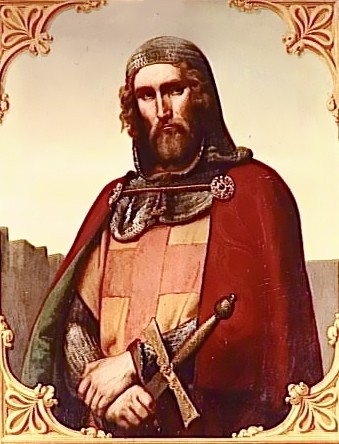 |
So Salah al-Din's engineers settled down to work the engines and pound
away at the isolated Citadel. For over a month Kerak held against the
siege, until Raymond of Galilee, Reginald's feudal adversary, crossed
the Jordan River with the army of Jerusalem to relieve the Stone of the
Desert. Then it was, Salah al-Din, who was not in strength, withdrew to the
north. But not before Raymond had come into his camp to talk with him,
and had agreed, as the Sultan also agreed, to a five year truce.
The young prince of Galilee saw in the truce the best safeguard of
Jerusalem. Salah al-Din wished it for reasons of his own. There was
trouble in the Moslem East and his forces were divided. Salah al-Din
departed the frontier.
In 1185 - King Baldwin of Jerusalem dies with no one to
succeed him. For a year no one wore the crown of Jerusalem. Noblemen,
priors and Grandmasters of orders, including De Riddeford, Grandmaster
of the Temple of Solomon, came and went and the talk in hall and
Monastery grew hot and fierce.
Finally, Reginald of Kerak rode into Jerusalem, and armed Templars
sallied out from their quarters in the ruins of the Temple of Solomon,
that once had been a Mosque. A cavalcade of spears from Ascalon entered
the gates at night, and in the morning the gates of the city were in the
hands of the followers of Sibyl, sister of the dead king. She claimed
the feudal right of succession.
In the Holy Sepulchre, at the coronation, the white surcoats of the
Temple and the gray coats-of-arms of Kerak surrounded Sibyl and her
husband Guy. When the ceremony was at an end, Sibyl lifted the crown
from her head, and placed it upon her husbands, bestowing the kingship
to him. |
|
Guy de Lusignan - King of Jerusalem |
Amalric, hearing of his brothers coronation, said, amazed, "Faith,
if they have made him a king, |
| they should make me a God." Time passed, and Reginald of Kerak found the truce irksome. Raymond
had made the truce, not he, and the Prince of Galilee was now in
disfavor. So when the great Moslem caravan from Cairo camped under his
castle with its multitude of slaves and tempting bales of exotic goods,
the master of Kerak could not hold back his hand.
He led down his followers and seized the caravan and held it, it spite
of Salah al-Din's instant message of protest, in which the Sultan
claimed the caravan as his own, under the safeguard of the truce.
Reginald's answer was to sally out against the long caravan of pilgrims
coming back from Mecca. Salah al-Din's patience was at an end.
"If Allah wills," he cried, "I shall slay that man with my own hand."
June 1187 - The black banners of Salah al-Din's army crossed the
Jordan at the ford just below the Lake of Galilee. This time there would
be no drawing back. Salah al-Din was determined to break the strength of
the Crusaders and drive them from the Holy Land. |
|
 |
|
Salah al Din's greatest triumph over the European
Crusaders came at the Battle of Hattin
This paved the way for the Islamic re-conquest of Jerusalem and other
Holy Land cities in the Near East |
|
Moslem Chronicles relate that Salah al-Din's Amirs advised
him at this time not to risk a battle, but to withdraw and lay waste the
lands of the Christian lords. Salah al-Din answered, "And when will such
a gathering be gathered together again in one place before us? Nay, be
ready to lead your men. God will do what He wills".
At the camp of Saffuriya the great Crusader Lords waited in
their pavilions. The days passed and they waited, while scouts brought
in word of the Moslems.
Salah al-Din had led his last contingents across the Jordan River, and
was camped along the heights by Galilee, facing the Crusaders, but a
mere fifteen miles away. Salah al-Din had a great host with him. Their
pickets were within sight. But Salah al-Din could not move upon
Jerusalem while the Christians watched from Saffuriya. He could not get
past them to the coast.
That night the Christian Lords gathered and held council in the pavilion
of the King, to determine what they must do. Some spoke of an attack to
drive the Moslems from their position at the brow of the rise, down the
great descent toward Galilee. Others, more cautious, explained that they
would find no water in the advance against Islam.
They then looked to King Guy for his council, "I have no will to press
the war," he said. But later, De Riddeford the Templar Grandmaster and
Reginald of Kerak went to the King's tent, and persuaded the irresolute
Guy to order an advance at dawn.
July 2nd, 1187 - The Crusaders marched at dawn, hoping to
reach the Moslem line at noon and break through before darkness.
But the intensity of the sun in the sky was a menace, and the marching columns
lagged. The foot soldiers were wearing mail armor and carried water. The
rocks beneath their feet radiated the same intolerable heat as the sky
above, and they faltered. When the sun set they were still far from the
Moslems. They camped and drank thirstily.
They had ventured too far, yet dangerously, not far
enough. |
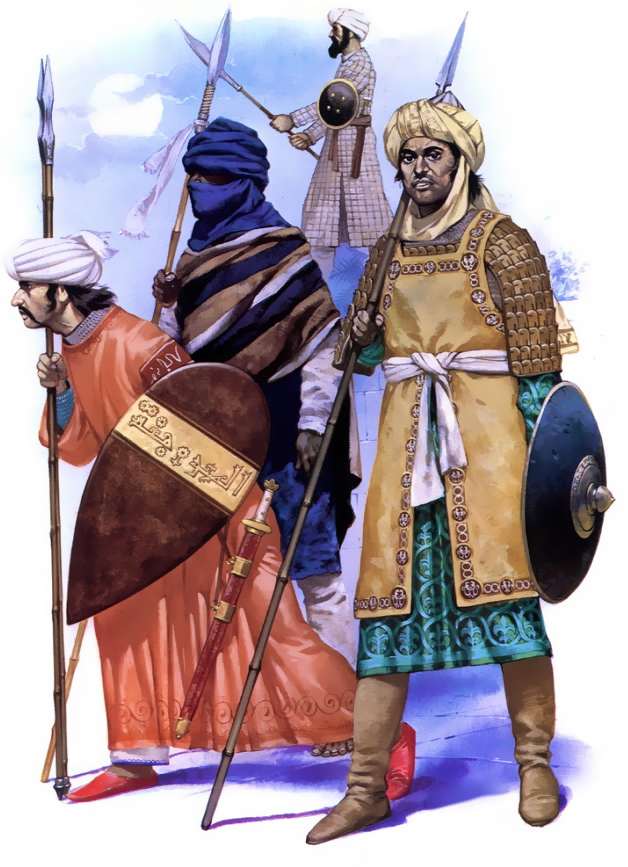 |
|
They could
not turn back. They had left the 'Springs of Saffuriya', and now
desperately, on the morrow, they must reach the water of Galilee. |
Moslem Arab Cavalryman
African Volunteer (Ghana Empire) |
|
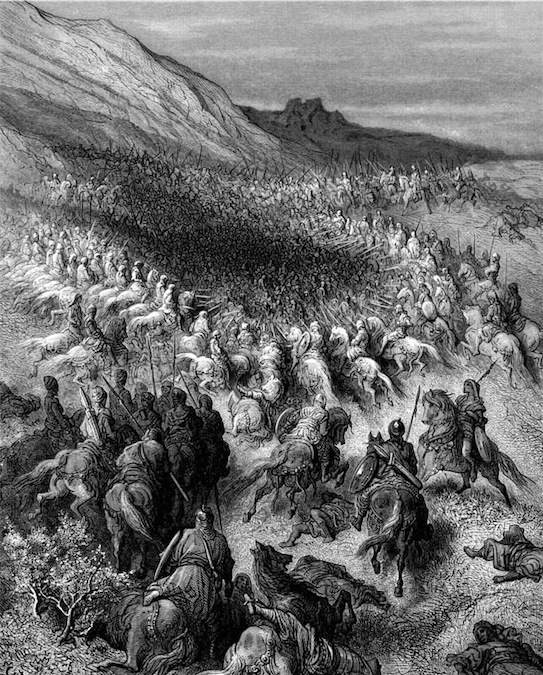 |
In the first morning blast of the sun they drank the last of their
water. Ahead of them drums throbbed and cymbals clashed. They saw dark
masses of horsemen moving under the black banners and the green banners
of Islam. They fought through the day; the knights, archers and
spearmen. They moved forward some, but they had not broken the line of
the Moslem horsemen. So the Crusaders waited in the darkness among the
dead, racked by thirst and weariness. The last of their water gone. "In
that place," the Moslem chronicler says, "the 'Angels of Death' kept
watch that night."
July 4th, 1187 - With the dawn the Christians took up their
weapons and came on again. "They advanced," the Moaslem chronicler adds,
"as if driven toward certain death."
The battle was fought in the village of Loubiya, under the rocky
hillocks known as the "Horns of Hattin". The fever of thirst
raged in the Crusaders. They fought for water and life. The way to
salvation was through the arrayed host of Salah al-Din, to the
water beyond at Galilee. In this intense struggle the Christian foot
soldiers became separated from the cavalry. The Knights, deprived of
support, made vain charges into the solid array of the Moslems. Horses fell under deadly arrows, or sank exhausted, and the Chivalry
of Jerusalem was forced to stand in order to defend themselves. Drawing
more and more into a dense circle, they were cut off from the
men-at-arms who scattered in groups, retreating up rising ground.
Only
Raymond of Galilee was able to lead some scores of riders in a desperate
charge that broke through the Moslem lines. He rode a spent horse to the
coast. Raymond reached his castle in Tripoli and died there two weeks
later of exhaustion.
By noon, this final day of fighting, the remaining Christian Lords
had gathered about King Guy and Reginald of Kerak, on the knolls of
Hattin, where the gold cross still gleamed.
|
They were surrounded and ceaselessly beset by Salah al-Din's cavalry, but held their ground,
wielding sword and battle ax, until the brush around them was set on
fire by the Moslems.
When the smoke thinned the Crusaders threw down their weapons, sat down
where they had stood, without strength to do more. So the Chivalry of
Jerusalem came to its end and the 'Battle of Hattin' ceased. The battle
had decimated the Knights and soldiers of Jerusalem. The remnants of the
fighting forces from the 'Kingdom of Outremer' sought refuge in the
fortified coastal cities and especially at Tyre. |
|
Salah al-Din and King Guy of Jerusalem |
| The Crusader nobility were rounded up and taken to Salah al-Din's
camp. Among them were Guy, the King of Jerusalem and Reginald of Kerak,
called the wolf. The Sultan had erected a tent for this special purpose.
The captured common soldiers were to be sold into slavery at the local
markets. The nobles were to be held for ransom, a process that could
take years. At the command of the Sultan Salah al-Din Turkish
swordsmen were cutting the heads from some 200 Knights Templar, being
those who had survived the warfare. It was the rule of the Templar Order
that no member could ransom himself. The Moslems treated the Templars
without mercy, except for the Grandmaster of the Order, De Riddeford,
whom Salah al-Din spared.
The grim warrior/monks knelt under the sword strokes without protest or
prayer for mercy. The law of Islam required that before an unbeliever
was put to death, he should be offered the chance of acknowledging the
faith of Muhammad, and if he accepted he should be spared. The Templars
made no reply and were executed. Many other soldiers wishing death
rather than a life of slavery in the service of infidels rushed forth
claiming to be Templars. Also, numerous Knights Hospitallers and other
Crusader Teutonic Knights were similarly dealt with.
Salah al-Din seated himself in his tent and bade his men bring in the
King, his brother Amalric and Reginald of Kerak. Then he offered a
sherbet of chilled rose water to the King, who was overcome by thirst.
But Guy only drank a part, and offered the goblet to Reginald of Kerak.
The Sultan said at once to the interpreter, "Remind the King that it is
not I but he who gives drink to this man."
For the Sultan had adopted the praiseworthy and generous custom of the
nomads who granted life to a prisoner if he ate or drank of that which
belonged to them.
Then Salah al-Din gave order to lead the three to a place prepared for
their reception, and when they had eaten, he asked for them to be
brought in again. The King he had sit in the vestibule. He required the
Prince of Kerak to come in, and reminded him of the words he had once
spoken, he said, "I am he who will serve Muhammad against thee!"
Salah al-Din then inquired if the Prince would embrace Islam? Upon
Reginald's refusal, the Sultan drew his sword and struck him a blow
which severed the arm from the shoulder. At this the servants sprang
upon the captive and finished him.
They drew Reginald's body out, and cast it into the tent entrance. The
King, seeing in what manner his comrade had been treated, believed that
he would be the second victim, and shook in all his limbs. But the
Sultan had him brought in and calmed his fears. "Kings," he said, "have
not the habit of slaying kings, but that man yonder had passed all
limits." |
|
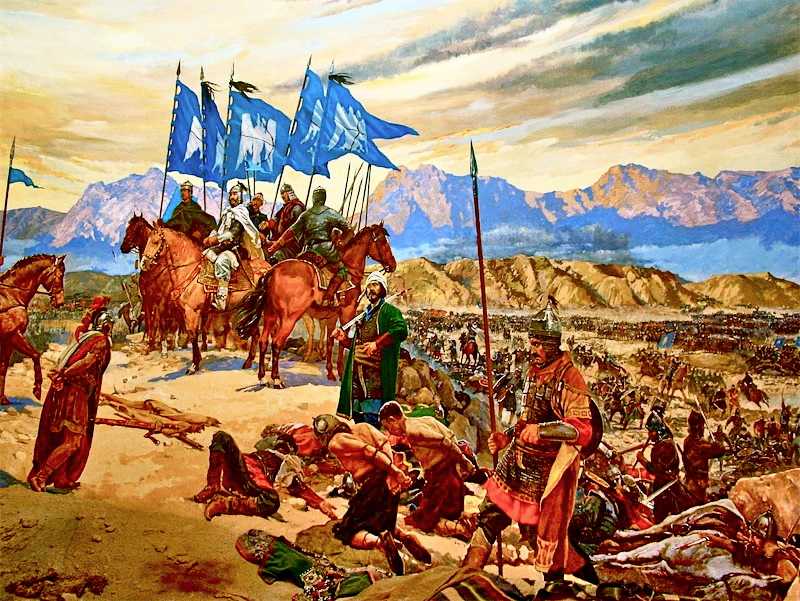 |
| The Christian fortified cities along the coast; such as Ascalon and
Jaffa, were beginning to hear of the terrible tidings at Hattin. More
than that, the great 'Citadels of Christianity' were now held only by
skeleton garrisons. Their feudal lords, almost without exception, had
been slain or taken at Hattin.
In the two months that followed Salah al-Din swept through the Holy
Land, successively occupying the remaining towns, cities and castles,
which had taken the Crusaders so many generations of effort and
bloodshed to subdue. Only in the east did several of the giants of the
Christian frontier still remain intact in their fortified mountain
heights. But the Moslems held all the country around them.
Now Salah al-Din's thoughts were bent on Jerusalem, where was built the
Al Aksa, the third most sacred place of Islam, built upon the gray rock
from which the Prophet Muhammad had ascended. Jerusalem was to be the
culmination of his conquest.
September 20th, 1187 - Salah al-Din's army camped on the western
height opposite the Gate of David, at Jerusalem. |
|
 |
|
"I will take Jerusalem as the
Christians took it, sword in hand" - Salah al-Din |
| Salah al-Din moved his camp to the high ground opposite the
northeast angle of the city. Here the siege engines were set up and a
barricade raised along the ditch to protect the miners, who set to work
to dig under the foundations of the wall. The unskilled Jerusalem
garrison had no proper engines to break down the barricade, and the
counter-mines they excavated collapsed. They manned the summit of the
wall and shot their arrows, but the veteran Mamluks and Turks made no
attempt at first to storm the stone rampart. Instead, the miners
enlarged their tunnels, propping up the foundation of the city wall, and
dug beneath it, until the props were burned and a broad section of the
wall cracked and fell in. |
|
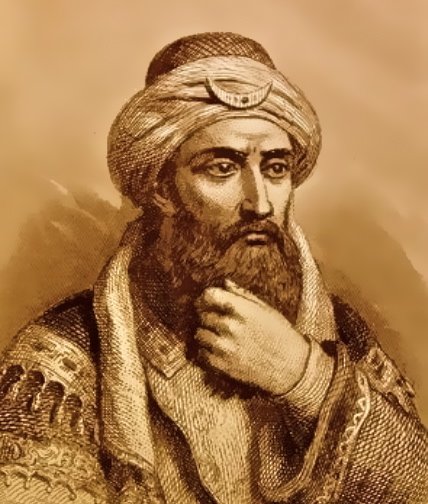 |
While the drums roared the Moslem swordsmen swarmed into the breach,
to be met headlong by arrows and slingshots and javelins. But the
Moslems gained the breach and held it, even fortifying it for their next
effort.
That night, while the priests and women marched in procession through
the streets chanting, the armed men, led by the Knights, surged out,
with the battle cry of the cross. "God wills it."
They drove the besiegers from the breach, and when the next day had
passed with its din of weapons and outcry of the wounded and the
maddened men, the Christians still held fast in the breach, against the
stones and shafts from the Moslem war engines.
The defenders sent out envoys to Salah al-Din, saying the men of
Jerusalem had pledged not to survive the loss of the city. They would
slaughter the horses and cattle, and pile the furniture in the churches.
They would set torches to the wood and burn the churches, with their
altars and vestments and relics. Women and children would be put to the
sword, and then the men, priests and warriors, would sally forth to find
death in their turn, killing Moslems.The Patriarch Heraclius said to
the leaders of the men, "It is not well to destroy ourselves thus. Nay,
it is better to yield the city and betake ourselves to Christian soil."
Next day the emissary Balian went out to parlay with Salah al-Din. The
enlightened Sultan had no wish to lay the city in ruins, and he agreed
to allow all the inhabitants to depart with arms and possessions. But
they must pay a ransom for safe passage. It was ten pieces of gold for
every man, five for a woman and one for a child. They were not allowed
to take any further gold or silver wealth with them. |
| Salah al-Din also agreed to conduct them safely to the coast. And
Balian accepted the terms. The next few days saw a strange sight. All
the gates remained closed except the Gate of David. From it a ceaseless
cavalcade passed out. Women, in traveling cloaks, laden with bundles,
rode forth with their children, while servants dragged cattle and herded
sheep beside them. Armenians rode out on donkeys followed by their
women. Barefoot, black robed monks came out, heads lowered, marching
behind their superiors and contrasted the gray habits of the
Augustinians. Behind them all the bells of the Church of the Holy
Sepulchre were tolling.
The men of Jerusalem came forth, seneschal and hermit, lord and beggar
and peasant. Among her court ladies, Sibyl the Queen of Jerusalem
appeared, with her sister and the widows of Hattin. Some went down the
road silent in pride, but others sought the Sultan in a throng and fell
on their knees to beseech that their husbands, captives of Hattin, be
released. They did not beg in vain, for Salah al-Din granted their plea.
All of them paid their ransom coins to the watchful officers, and only
the Patriarch Heraclius went out with his private treasure hidden in
sacks upon his beasts. He carried out gold, although thousands of the
poor remained weeping in the city, unable to pay the ransom tax. But
Salah al-Din released the poor from his tax and even forbade his men
from confiscating the fortune of the Patriarch. Salah al-Din, when the
money was brought to him, gave it out to the Moslem soldiers.
No miracle had saved the Holy City, but a strange thing had happened.
For the Moslems had taken possession of Jerusalem without blood being
shed. And this was brought about by Salah al-Din's mercy. |
|
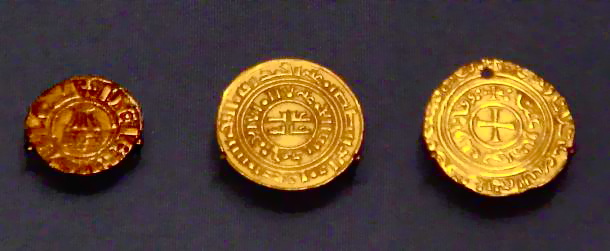 |
|
Crusader Coins from the Kingdom of Jerusalem (Outremer) |
| Note: Though Jerusalem was captured by Salah al-Din's forces
in 1187, the Crusaders retook the city in 1229, without Templar
assistance, but held it only briefly. In 1244, the Khwarezmi Turks
recaptured Jerusalem, and the city did not return to European control
until 1917, when the British took it from the Ottoman Turks. |
|
Salah al-Din Victorious - Painting by Gustave Dore |
|
 |
|
In 1189 - Jerusalem had fallen two years earlier to Salah
al-Din. All of Christendom had been calling for a new Crusade. So the nations of Europe launched the Third Crusade to win back the Holy City, called
by many the
"Glory of the World". A letter came from Friedrich
Barbarossa, known as the 'Red Beard', who
was by divine mercy the Emperor of the Romans, and lord of all German
states and principalities. The Emperor threatened that if Jerusalem were
not surrendered, he would come against the Moslems with all his great
host. "Take warning by Pharaoh and yield Jerusalem." The Arabs knew who
Barbarossa was; the chief sultan of the Franks and the defender of Christiandom.
Spring 1189 - Barbarossa set out upon the 3rd Crusade. The Red
Beard led an army of one hundred thousand soldiers. Even as Barbarossa
marched the Duke of Austria was preparing to follow him. The French
Chivalry were mustering for the road, and their young King Phillip II,
had taken the cross. The fleet of Norman Sicily was anchored off the
port of Tripoli, while the ships of Pisa were already under way. Even
the sails of the Northmen had been seen off the coast of Granada.
Watching the gathering storm, Salah al-Din knew this would be the real
war. The Christian forces he had defeated several years ago had been no
more than a fragment of these new armies. The kings and queens of the
Franks would merge their forces into a mighty host, greater than his
own. Perhaps he might face a quarter million fresh foemen, under new
leaders. Salah al-Din himself had never had even fifty thousand warriors
under his banners at the same time.
On the sea also, Salah al-Din's Egyptian fleet would be confronted by a
greater armament, and he was prepared to see the Christians victorious
on the water. The Christians could, thereby land at whatever point they
wanted along the coast of Outremer, while Barbarossa's massive army
marched down through Asia Minor and the mountain passes.
The armed forces of Europe would converge on his coast. It would be a
duel between the resources and weaponry of the West, against the
horsemen of the East. |
|
Philip II the King of France |
Richard the Lionheart |
Emperor Frederick Barbarossa |
The Crusaders at the coastal city of Tyre had held out against the
Moslem assaults. Tyre would remain under the control of Europeans until
a century later, when it would be taken by Mameluk forces.
Conrad was the Lord of Tyre. He was now the Marquis of Montserrat, since
his father, a captive of the Battle of Hattin, had died. Conrad was an
adventurer. Conrad married a Byzantine princess and spoke all languages.
His main skill was in war. Conrad had preserved Tyre from Salah al-Din's
assault. Conrad had even refused to yield Tyre to save the life of his
captive father, when the aged marquis was brought before the walls.
Conrad said, "My father has lived long enough, in any case." Conrad is
said to have had firm friends and bitter enemies.
When the refugees from the battle at Tripoli landed on the beach beside
the city of Tyre, Conrad barred them from entering. The powerful Conrad
would not yield his place to a weak King. So Guy, uncertain, pitched
tents on the shore.
But many in Tyre had pledged their faithfulness to the King. Numbers of
Pisans and Germans left Conrad to join the King, so that by late summer
he had four hundred Knights and seven thousand other fighters with him.
With him also were the Queen Sybil, and his advisor, the Grandmaster of
the Temple De Riddeford.
With the Moslems swarming around him in the hills, and the Christian
fleets drawing nearer, King Guy set out from his camp at Tyre and
marched on the great city of Acre.
"Never," cries the chronicler, "did another show such audacity, and it
is truly wonderful that he had the enterprise to go fight men who were a
hundred to his four!"
Salah al-Din, beset by malaria, was surprised that Guy would attempt
such a foolhardy venture. But he made no protest. He preferred to have
the weak Guy in command of the Christians. He had released the King with
that end in mind.
Salah al-Din, even in his illness, was closely watching the north,
listening for the approach of Barbarossa. He was also watching for the
sails of the Crusader fleets that might land anywhere from
Constantinople to Cairo, Egypt. Salah al-Din did not know that
Barbarossa was already dead. The old Emperor had been at the head of his
army, within sight of the Armenian Mountains following a desert march;
when at a ford, where the freshet ran deep, his horse had stumbled,
throwing him, clad in mail armor, into the water. Much of Barbarossa's
army had already returned to Germany following his demise. |
|
 |
Upon arrival at Acre, King Guy positioned his forces on the high
grown, occupying a series of hills above the orchards, a half mile from
the sea. The men labored at digging a ditch around the mound-like hills.
All through the night they worked and in the morning they diverted the
water from the nearest steam into the ditch, so that they had a fairly
good moat around the camp. Then they began to raise an earthen wall
behind the ditch/moat.
The Moslems in Acre took great interest in these activities by the
Christians, and sallied out to skirmish in the plain. But the garrison
at Acre was really waiting for Salah al-Din to come down from his hills
and the Christian Knights did not venture far from their lines. All
night vigilance of arms was required against the attacks of the
Saracens. But the Crusaders could raid the plains for supplies and had
plenty of water.
On the third day, the troops of the Sultan Salah al-Din came; Turks,
Persians and Bedouins. They occupied the country all around. The Turks
assailed them night and day. The King and his men were in great fear and
they watched the sea, until shortly, there arrived a great fleet of
ships. It was James of Avesnes, from Flanders. He had with him fourteen
thousand renowned men-at-arms. Then soon arrived the fleet of Danemark,
carrying castellans and their brown horses, strong and swift.
Galleys and ships were run up on the beach near the city, and the
newcomers fought their way across the plain to the camp of the King.
Conrad of Montserrat arrived from Tyre in his ships to join the
gathering host. The Crusaders now numbered more than thirty thousand and
their ships blockaded the port of Acre. They extended their lines on
either side, so the King's camp became a semicircle, isolating Acre from
the hills controlled by Salah al-Din. Autumn 1189 - Salah
al-Din made an effort to break the line the Christians were extending
around Acre. Always faithful to Islam, he attacked on a Friday, when
Moslems all over the world were at prayer. He launched his cavalry at
different points along the Christian line, to break the close ranks of
the stolid infantry and to separate the divisions of the Crusaders.
The Templars and the Hospitallers of St. John of Jerusalem charged,
assailed the first ranks, pierced them, threw then into disorder, drove
them to flight and pursued them. When the Knights charged, the Moslem
general Taki ad-Din decided to draw back his cavalry line to higher
ground, and Salah al-Din mistook this maneuver for flight. The Sultan
sent his reserve cavalry from the center to the retreating right wing.
The commanders of the Christian center noticed this weakening of the
Moslem center and charged point-blank at the Sultan's standard. Some
Moslem regiments were broken and driven back, but Salah al-Din's
Mameluks held fast without breaking ranks. Salah al-Din made every
effort to break the Christian line and failed. While the Crusaders had
been cut to pieces on the first day of fighting, they held their ground
thereafter.
But the year grew late, the Autumn rains were beginning, with the holy
month of Ramadan, and the Amirs were eager to return to their homes for
the Winter's planting. The Sultan himself was still ill with Malaria. So
they argued and persuaded Salah al-Din to cease the battle till the
Spring. No new Christian fleets could approach the coast of the Holy
Land during the stormy season, nor could they blockade fully the port of
Acre. |
|
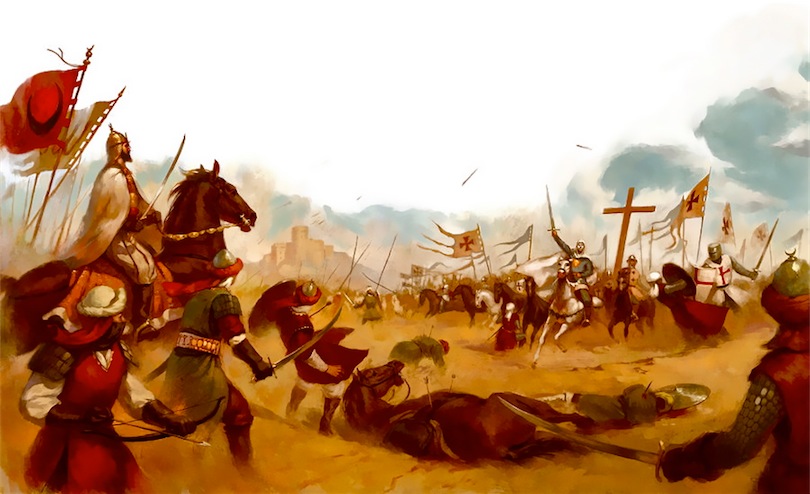 |
The Crusaders, from their position, could clearly discern Acre.
Rising over the inner wall could be seen the watch towers of the
Templar's Sanctuary, and the terraces of the Hospital of St. John. Acre
had been built almost entirely by the Crusaders. The Moslems had only
held it for two years, the aftermath of the Battle of Hattin. Many of
the Crusaders and especially the Knights Orders, knew every stone of the
great city wall. Upon the summit of that wall, four horsemen could pass,
riding in different directions. It had mighty towers and fortified
gates. The Crusaders knew scaling ladders would not suffice.
To enter Acre, the Crusaders must build engines powerful enough to open
a breach in the wall, but nothing could be accomplished during the
deluge of rains season that was upon them.
Spring 1190 - The war began again, with the cessation of the
torrential rains on the shore of the Holy Land.
The siege engineers of the King began work upon the machines necessary
to breach the wall of Acre. They must be both massive and resilient.
Meanwhile, the galleys from Tyre sailed down with the Genoese Fleet. The
Crusaders thronged the shore, watching the daily skirmishing between the
Christian ships, and the Moslem galleys out from the port of Acre.
Soon three great 'Siege Towers' creaked slowly along, swaying,
and sliding over stone rollers, drawing ever nearer the outer wall,
while Mangonels upon their summits spewed iron darts upon the
battlements. The towers were colossal, each with a compliment of five
hundred men within it. One carried the banner of the Landgrave, another
that of King Guy, and on the third, the banner of the Marquis Conrad,
who had come from Tyre for the assault.
From the embrasures of these moving pyramids crossbows fired and their
iron quarrels whirred over the parapet of the wall. When they struck a
man they tore through shield and mail and flesh and bone. From the
barricade on the tops of the towers skilled archers loosed their arrows.
On the wall, the Moslems labored to destroy the towers before they could
approach too near. Under the expert direction of Karakush, a Mameluk who
knew all the 'Arts of Siege and Defense', engines on the wall cast
stones against the towers. But the Christian towers were built of solid
beams joined together. The beams cracked and yielded, without breaking.
Other defensive engines shot out flaming timbers that struck down the
men on the tops. But hides soaked in vinegar covered the tower wood and
prevented the fire from catching.
Then Karakush brought forth three large copper cylinders from which
short tubes projected. These were placed opposite the wooden towers,
into the arm of a stone caster. Released, the whirling copper bombs
shattered against the damaged faces of the opposite towers. Flames
roared from the bombs and streams of fire shot into the the framework of
the beams. Within the towers the Crusaders could not go near the
incendiary device, so the fire caught and spread with the wind. By
sunset on that day the three mighty towers lay in smoking ruins.
The Crusaders had heard of this terrible weapon called, 'Greek Fire',
but this was the first time they had experienced the effects of it. It
is reputed to be composed of a combination of 'Sulphur and Naphtha', and
it burns wildly, insidiously. |
|
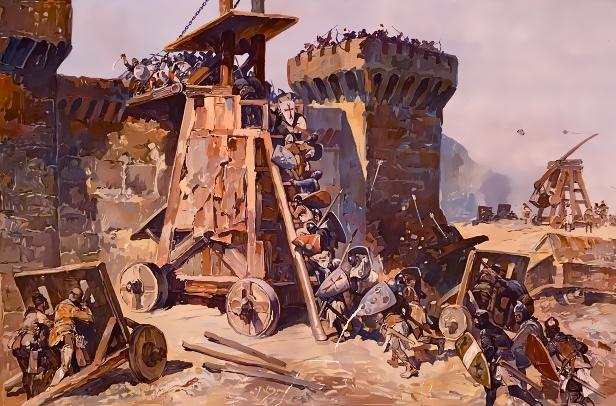 |
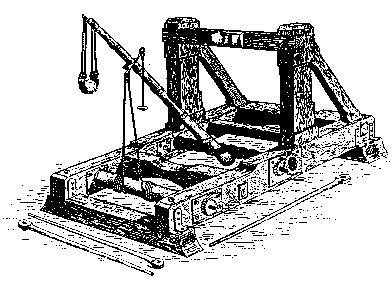 |
|
Siege Warfare in the Holy Land |
Mangonel |
From his base in the foothills, seven miles away, Salah al-Din
watched and weighed events. He saw the steady increase of the Crusaders,
and unseen messages reached him hourly from Acre, via carrier Pigeons.
At this time Salah al-Din had to force his Malarial Fever racked
body to sit the saddle on his horse.
Summer 1190 - The Crusaders were closing in on the
wall with grim determination. The battle of the siege engines had begun
again. The great war engines opposed each other, in defense and attack.
They fought titanic duels against each other with boulders and tree
trunks as missiles, until one or the other was broken down. The pigeon
reports reaching Salah al-Din told of a Christian Mangonel destroyed by
a great iron arrow, its tip heated red hot, shot from the wall.
One massive siege engine had advanced close to the wall, near a gate.
The Moslem defenders of Acre sallied out the gate unexpectedly, drove
off the Crusaders, and held their ground long enough to set fire to the
interior of the giant machine. This success encouraged them to try
another sally. The Moslems had armed themselves with some kind of flame
projectors, and when the Crusaders rushed at them, streams of Greek
Fire were turned on the armored Knights; burning through cloth and
skin, and shriveling the flesh beneath the searing metal. While the
Christians rolled and twisted on the ground in agony, the Moslems turned
the flames against a line of Mangonels, and burned up many of them.
Gangs of Arabs made nightly raids upon the Crusaders' horse lines and
seldom returned without trophies of some sort. They even crept through
the guards. Clad in black, and moving silently like animals, they stole
into the huts where men lay sleeping, and awakened the sleepers with
knives at their throats. Holding fast to their prisoners, they explained
by signs that an outcry would result in a slit throat. Then they stole
back with their captives through the lines.
Autumn 1190 - passed quickly as the stalemate continued. Then the
rains began again, but brought no respite from warfare this time. Famine
had come with the Winter and day by day it grew worse. They skinned good
war horses and ate the meat voraciously. Even the entrails were eaten.
In spite of famine and sickness the siege was pressed.
April 1191 - The second year of the siege. Six great ships sailed
in, one of them bearing the standard of France and the King, Phillip II,
Augustus. With him were assembled much royalty, including the Count of
Flanders. The newcomers to the battlefield were informed that, "Here,
more men fell in a single battle than in a year's campaigning in
France."
Now the French pushed the attack on Acre with a new spirit, pounding the
crumbling wall with their engines. At each attempt, Salah al-Din's
horsemen, warned by the beating of drums in Acre, swarmed to attack the
outer line of the Crusader's camp. |
June 1191 - Twenty-five galleys and ships sailed in to the
shore at the Crusader's encampment. A clamor of horns greeted the
leading galley, a red vessel bearing the banner of England. The Moslem
spies hastened to Salah al-Din with word that Richard, King of England
and landed.
Richard the "Lion Heart" had reached the Holy Land, but not yet
the battle. On a dais covered with leopard skins, he writhed, twisting
in the grip of fever, his lips and throat covered with sores. His
powerful body reduced to quivering with weakness. The plague was raging.
Out of twelve thousand Scandinavians who had come in their ships, not
two hundred survived.
Prior to the plague debilitating him, England's King Richard, at
thirty-four years of age, was in the prime of his life. He was
intolerant of weakness. He was a King of tournaments and banquets. And
in war, he must be the leader. In all things, he was a tiger.
At Acre, the siege engines of the war whirred and crashed through the
day and the night, relentlessly. A permanent cloud of dust hung about
the besieged walls of the city. Great stones soared from the Crusaders
catapults, falling upon the roofs within the city. From the Moslem
engines on the wall, projectiles fired buried themselves a foot into the
earth.
The Crusaders rolled forward a new tower, higher than the wall, sheathed
with copper. Upon this engine the Moslem defenders shot clay pots for
hours on end. The pots broke and drenched the structure with a fluid.
Finally, a flaming tree trunk was sent spinning through the air against
the tower. In an instant, the whole tower burst into flames, roasting
alive the men within it. The liquid in the pots had been Naphtha.
Another fleet put in to the shore, carrying the last of the French
contingent and the best of the English men-at-arms, along with King
Richard's legendary siege engines. They entered into the battle without
even a day's rest. |
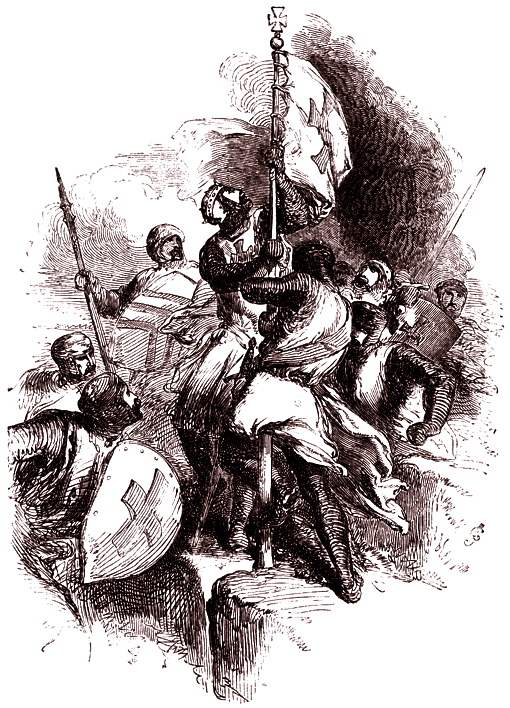 |
The Christian besiegers, maddened by losses, fought now without
giving or expecting mercy. The Crusaders now numbered nearly one hundred
thousand fighters, and the wall of Acre had already been broken by the
assault of the French. The city was held by no more than six thousand
Moslems.
Day and night the pounding of the engines went on, while the English
mined under a tower and the city defenders drove a tunnel out to meet
them. Atrocities were exchanged. New arrivals to the Holy Land burned a
Moslem prisoner alive within sight of the wall, and the city garrison
retaliated by burning a crusader at the stake.
No more pigeons remained to carry news to Salah al-Din. But a messenger,
swimming out from Acre, managed to reach the Sultan's camp. "We are
reduced," the letter read, "to such weakness that the city will be lost
if you can not do something to aid us by the morrow."
July 2nd, 1191 - On that day, the Crusaders advanced again to
press the attack. Salah al-Din came down from the hills with all his
strength. At the core, the veteran guard in yellow cloaks, with the
cavalry columns of the ever victorious Taki ad Din, and the mailed
Mameluks of Egypt, led by Al Adil, his brother. On the flanks rode the
wild clans of the northern hills; Turkomans armed with long curved
blades and javelins, dark Kurds of the east with their lances and
painted shields, and beyond them, the Arab tribes hovered like birds of prey,
ready to swoop in and snatch up plunder.
Al Adil charged simultaneously with Taki ad Din, and the Dervishes ran
between the horses, screaming, knives in lean hands, while the Imans
watching in the hills intoned an endless prayer. Hours passed and the
trench line of the Christians held fast. At twilight the Moslem cavalry
withdrew.A pattern continued daily. At daybreak Salah al-Din ordered
the war drums beaten again. The soldiers began to form their squadrons.
Attack and counter-attack followed. Acre was constantly hammered. One day, the English
finally set
fire the wooden beams of the tunnel they had dug down under the
foundation of the wall's square tower. Slowly the tower inclined
outward, but it did not fall. Then the sound of battle roused Richard, King of England,
and he could endure his sick bed idleness no more. He ordered attendants
to carry his pallet out to the battlefield that he might observe the
carnage. He offered gold coins as incentive for anyone to pull the
stones from the tower base. |
| Through the hours of darkness men labored around the tower. Near
dawn, the "Accursed Tower" came down at last, in clouds of smoke and
drifting dust. A wide hole gaped in the angle of the city wall. The
Crusaders charged the breach and met a counter charge of desperate
Turks, who fought with knives and broken swords to hold the breach until
others came up with flame throwers. So were the English beaten back from
the breach. But it was the last of the fire the Moslems possessed. |
|
Richard the Lionheart - Victory at Acre |
| July 12th, 1191 - Acre falls to the Crusaders. The people of
the city of Acre, facing certain death, made a treaty to surrender. For
the following 100 years the Crusaders ruled Acre. |
| The Knights Templar still had great influence, but the leadership of
the Crusade now lay between the kings of France and England, supported
as they were by the powerful aristocratic princes of Europe. Philip
Augustus, the King of the French, announced his decision to sail back to
France at once, following the fall of Acre. He had seen enough of the
Holy Land and its privations, so he used illness as an excuse. The
French contingents protested and the nobles urged him to remain till the
war's end. He would not stay. He left behind the bulk of his army.
Richard the Lionheart was chosen the unquestioned leader of the Crusader
military forces. Richard was pleased. His illness was conquered, no one
to hinder him, and all of the Holy Land open to him. Only Conrad of Tyre
dared question Richard, and Conrad had retired to his citadel. Nor would
he come forth at the Lion Heart's summons. Acre had surrendered under
hard terms. To save their lives the generals in the city had agreed to
turn over Acre and all that it held. Also they promised, the payment of
a ransom of 200,000 pieces of gold, and to the release of 1,600
Christian captives held by Salah al-Din, including 100 Knights selected
by name, and to return the 'Holy Cross' of the Crusaders. The
fulfillment of these terms rested entirely with Salah al-Din, who was
troubled when he heard of the conditions.
The payments were to be made in three parts, over three months time.
Salah al-Din said he was ready to make first payment, if the Christians
agreed to give hostages to show good faith. Richard the Lionheart
refused, demanding payment be made unconditionally.
Days passed without response and the Lion Heart called a council of
princes at Acre. He discussed the situation and came to a decision.
Twenty-six hundred Moslems of the city were led out into the plain.
Their hands were bound and they were put to death by the sword or hung,
within sight of the Moslem patrols watching from the hills. Only the
higher officers were spared.
In a frenzy of rage all the Moslem cavalry in the area rode down at the
Crusaders, and before the executions ended, swords were clashing all
over the plain. Eventually, the Moslems withdrew, to carry word to Salah
al-Din. For many a day Salah al-Din showed no mercy to any Crusaders
taken captive. He did not, however, retaliate by a slaughter of the
Christians already in his hands.
The Crusaders were still afflicted by their losses at Acre, especially
considering the terrible effects of the insidious "Greek Fire". The
majority of them, arriving on the coast during the tension of the siege,
still looked upon their enemies as infidels to be slaughtered wherever
met. Despite that, King Richard stained his name, memory and honor by
this needless cruelty. Salah al-Din on the other hand, did not
retaliate, except in the open war that followed.
August 25th, 1191 - King Richard led the Crusader army down the
coast with the fleet following after him, toward Jaffa, the port city of
Jerusalem. In this manner he arranged for supplies to be delivered to
his troops as they marched along the coast. This march was more than one
hundred miles over the trails. The march was launched during the worst
of the heat when the streams were dry.
Salah al-Din kept in touch with the Christian's movements by spies and
by mounted patrols. He ordered the walls of the three towns between Acre
and Jaffa dismantled, and the fortifications of the Jaffa seaport
destroyed. Salah al-Din marched his forces south, beside the Crusaders,
out of sight and sound within the hills. As the Crusaders marched on the
Moslems made harrying attacks upon their columns. |
|
 |
The Crusaders marched in three columns. The one nearest the hills,
and the enemy, was formed entirely of infantry in close order. Those in
the outer files exposed to the Moslem arrows, carried bows and
crossbows, and wore shirts of felt and mail armor. They worked their
bows without halting, and their armor shielded them from the hostile
arrows. Within these files, their comrades carried spears and swords in
readiness to stand and beat off a charge.
The second column, within the infantry screen, was composed of the
Knights and horsemen, the real strength of the army, which was protected
in this way from the arrows that would otherwise have taken a toll of
the valuable horses.
Nearest the sea and remote from the Moslems marched the third column
consisting of the carts and baggage, and the sick and injured.
Assessing Richard's route, Salah al-Din elected to make a stand near the
town of Arsuf, to the north from Jaffa. Arraying his men facing west, he
anchored his right on the Forest of Arsuf and his left on a series of
hills to the south. To his front was a narrow two mile wide plain
extending to the coast.
September 7th, 1191 - On the day of the battle the Christians
moved forward in their dense column, an armored giant drawing itself
along the ground, heedless of the sting of missiles.
The Knights Templar took the advance position in the column, followed by
the Bretons and the Knights of Anjou. King Guy led the men of Poitou at
their heels, and the Normans and English pressed after with the
standard. Bearing the burden of attack, the black robed Knights
Hospitaller held the rear guard. At nine o'clock the two sides were
engaged. Swarms of Bedouins and the horsemen of Egypt were assailing the
Hospitalers at the rear. The battle fell heavily upon them without
respite.
Then the Grandmaster of the Knights of the Hospital of St. John rode to
King Guy and told him of their ordeal, emphasizing the heavy losses of
their horses, though the Knights were well protected by their armor. The
King replied, "No one can be everywhere at once." And the Grandmaster of
the Knights of St John returned to fight off the attackers.
There was a great shame felt by the royalty, the counts and princes.
They conversed among themselves and asked each other, "Why do we not
charge them at full gallop?"
Spontaneously, two Knights who were impatient of delay put everything on
the battlefield into confusion. They rushed at full gallop upon the
Turks and each of them overthrew his man by piercing him with his lance.
One of them was the Marshal of the Hospitalers and the other Baldwin de
Carreo, a brave companion of King Richard. |
|
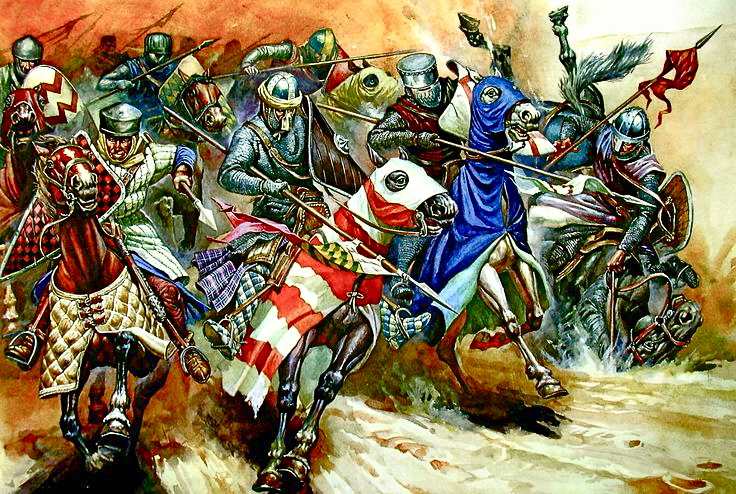 |
Then seeing this unfold, the Crusaders charged the Moslems in a body
with all their strength. The Knights of St. John of Jerusalem, who had
suffered distress all day by their position and formation, charged the
enemy in troops. So the rear guard became the vanguard of the assault.
The Turkish cavalry, who had dismounted in order to take better aim at
the Christians with their javelins and arrows, were slain on all sides
in that charge. Their position being overthrown by the horsemen, they
were killed by the foot soldiers who followed.
Richard the Lionheart, seeing his army already in motion, flew on his
horse through the Knights of St. John to attack the Turks. There the
fierce King, the extraordinary 'Warrior King', cut down the enemy.
Wherever he turned, the Lionheart killed a wide path for himself. The Turks were
astonished at his blows and those of his men, and gave way right and
left. Then were seen numbers prostrate on the ground, horses in swarms
without their riders, and many trodden underfoot by friend and foe.
Richard scattered those he met, as men fell quickly before him. The
enemy gave way and retreated.
The Crusader charge swept all the Moslem divisions back against the
hills with heavy losses. In this charge the men of Islam experienced for
the first time the astonishing power of the Lion Heart. On this day in
history, 'Malik Ric', as the Moslems called him, gained a place in
Islamic legend. Their solid defeat lowered the morale of the Moslems
significantly.
The Crusaders proceeded on their march as far as the little seaport of Arsuf.
There they pitched tents outside its walls. |
|
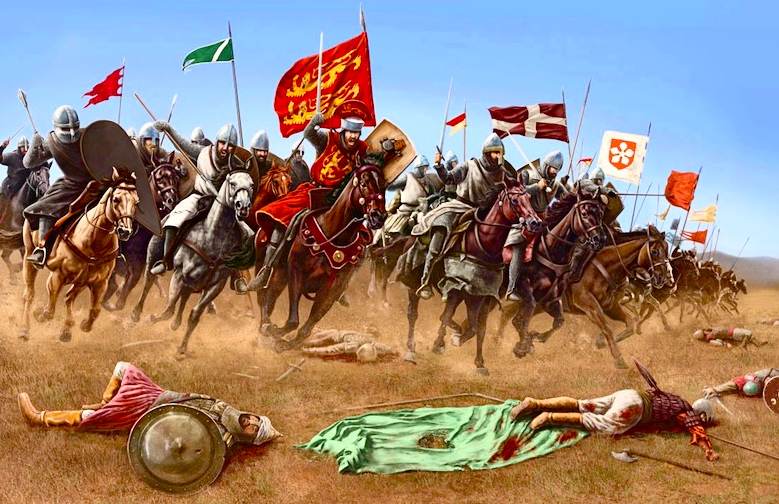 |
|
Richard the Lionheart at Arsuf |
| Salah al-Din changed his tactics. He destroyed, instead of defending
Ascalon, called the "Bride of Syria". Ascalon, the southern key to
Jerusalem and to the caravan route into Egypt, was a great and fair
seaport, but the Moslem Amirs were in no mood to shut themselves up in
another Acre, to defend it.
The Crusaders occupied Jaffa, which had been abandoned, and they
rested there. October and November passed while Jaffa was rebuilt and
fresh forces summoned up from Acre. Skirmishing was the extent of the
combat. King Richard relished in it. The opportunity for individual
combats delighted him. The Lion Heart often rode out, with a small
retinue of Knights, to look for hostile Moslem cavalry patrols and ride
them down.
Salah al-Din knew from his spies that the Crusaders had returned to the
shore of the sea. It was growing late in the year and rain came on the
heels of wind, and chilled the air. So Salah al-Din informed his
Saracens they could go away to their country and rest until May. They
went willingly, having remained four whole years on the expedition.
1192 New Year - While King Richard labored at rebuilding
Jaffa, Conrad of Tyre was secretly negotiating with Salah al-Din,
offering to wage open war on the Lion Heart, if the Sultan would pledge
him more of the coast cities. But Conrad was the one ruthless man that
Salah al-Din was most wary of.
April 28th, 1192 - A strange power from beyond the mountains
intervened. Conrad, riding home from a banquet at the house of the
Bishop of Beauvais, was attacked by two young men and stabbed. These two
Ismailites (Assassins), clad in the habit of monks rushed upon the
Marquis who was mounted on his horse. One of them struck him with a
knife, and the other fled into a church nearby. The wounded Marquis was
carried into this same church by his companions. When the second
assassin monk within the church beheld Conrad alive and speaking, he
rushed out at him in the middle of the church and struck him again.
Shortly, Conrad of Tyre died of these wounds. These two Ismailites were
seized, and crucified, and tortured by the Crusaders. They told of how
the King of England had sent them.
|
|
King Richard's March to Jerusalem |
| Summer 1192 - King Richard announced all should make ready to
march on Jerusalem. When the Lion Heart marched inland to besiege
Jerusalem, he found that Salah al-Din had stripped the countryside of
food and fodder. The wells had been poisoned and King Richard realized
that his army would fall apart from thirst and starvation if he tried to
besiege Jerusalem.
And so, at the very walls of the 'Holy City' itself, the Crusaders
were forced by conditions to relinquish their plans for assault and
siege, and instead return to the coast, with different contingents
taking diverse routes to various destinations. Angered past
reconciliation, the French went off to the north; the pilgrims and
masterless men trilled down to Jaffa, while the Italian soldiery
hastened to their citadels of trade along the coast, and only the
Knights Templar and the Hospitalers of St. John, remained to guard the
new wall of Ascalon.
Richard the Lionheart went at once to Acre, and joined his queens
waiting there (Berengaria of Navarre and a young Princess of Byzantium),
as he was impatient to embark for England. And the French sang a song in
the taverns about a coward and a king, that stung the pride of the red
haired King. So it came to be the Christians were scattered, and
divisive.
Salah al-Din seized the opportunity. He roused his Amirs, shook from
them the inertia of the year's defensive caution, and launched his
horsemen straight down from Jerusalem towards Jaffa. They came like a
sword thrust out of the night, twenty thousand mounted men with siege
engines on camel and mule back, and a wild, exulting mass of Arabs
clinging to the flanks. They drove the surprised Crusaders from the
fields and suburbs, and began to pound with rocks and iron javelins at
the gate of Jaffa. A ship sped to King Richard at Acre with news of the
attack.
The galley bearing word of the Moslem attack reached the harbor of Acre,
when King Richard was in his tent making the last preparations for
embarking toward Beirut, and then on to Europe. The messengers went
before him without ceremony, crying that Jaffa was taken and a remnant
of the Christians were besieged in the Citadel of Jaffa. All would be
lost they said, unless aid reached Jaffa at once.
"As God lives," Richard answered, "I will go there."
The Lion Heart was in command of the galleys that drifted beyond the
swell of the Jaffa beach. The French refused point-blank to march under
his standard. The Templars and the Knights of St. John of the Hospital,
agreed to rendezvous at Jaffa, but were held up en route by a Moslem
ambush. The fleet reached the beach in the night and waited to see what
story the dawn held. |
|
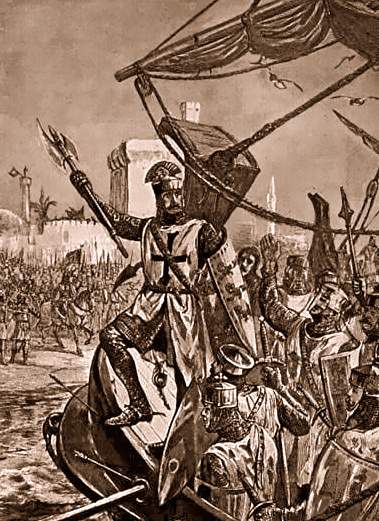 |
When the mists cleared and the sun rose above distant hills, they
saw the beach was filled with Arabs and Turks, who were obviously camped
there. The Crusaders feared all the Christians were already dead, as
they could hear no shouts for help over the chants of the Moslems. Then
a black figure dropped from the wall of the Citadel to the sand of the
beach below. He fell but arose again and ran through the Moslems to the
edge of the swell. Plunging into the water he swam toward the nearest
galley, which moved in and picked him up. The swimmer was a priest and
was taken at once to the long red galley over which the King's banner
floated. The priest informed that some still lived, shut up in the
towers. Richard the Lionheart looked at his companions and told them,
"Damed be he who hangs back." He ordered his vessel to row in. His ship
was first to beach itself in the sand. He led the assault, the first
ashore, as he jumped over the side, landing waist deep in the water. The
Lionheart still wore his ship slippers with no other armor than a mail
shirt and a steel cap. On his shoulder he gripped a crossbow and his
long sword hung at his side.
Wading through the swell with two Knights, the King began to shoot bolts
at the foes. When they came out of the water they drew their swords,
lashing about, while the shipmen plied arrows from the prow of their
ship. Recognizing "Malic Ric", the Moslems in front of him gave back
hastily, for his reputation was already fearsome. Meanwhile the English
hastened forward to form a shield ring about him. Other ships were now
running up on the beach.
But the Lion Heart, took a shield from a soldier and ran across the
beach to a postern gate in the wall and a stair that he remembered led
to the Templars House. With his Knights behind him, he leaped up the
stairs and the Arab looters of the alleys yelled in amazement. The King
cleared the alleys and pounded at a gate of the Citadel until the
garrison became aware of him.
By this time, Richard the Lionheart's galleys held the beach and
his own men were streaming up the Templars' stairway. |
His banner was raised on the tower of the Citadel for all to see for
miles around. The beleaguered Knights of the city garrison took new
heart at his coming and sallied forth to attack. They began to drive the
disorganized Moslems toward the gates of the outer town.
King Richard's quick, courageous action brought extraordinary results.
On his heels the men from the galleys successfully broke into the
waterfront of Jaffa, before the disciplined portions of Salah al-Din's
troops could come up to oppose them. The rout of the Moslems in the
streets had thoroughly disorganized the army outside, as they could not
enter the city with the exodus of fleeing people. Salah al-Din was
forced to draw back in haste to the nearest hills to take stock of the
situation.
Richard had saved Jaffa. Word of the return of 'Malik Ric' spread over
the countryside.
Salah al-Din still desired a final victory, but knew his troops were
weary of war and no gain could come of fighting on. "I fear to make
peace," Salah al-Din said, "for I know not what will happen if I die."
King Richard fell ill again, as did many of his people. In the heat and
stench of the town, which was little better than a shambles, men died
swiftly, and even the King did not regain his strength. Richard was
ready to negotiate terms of peace and make his journey home to England.
September 2nd, 1192 - King Richard and Salah al-Din signed a
treaty that left Jerusalem under Moslem control, but allowed unarmed
Christian pilgrims to visit the city. The terms were simple. Each side
would keep what it held at the time. The Christians became acknowledged
masters of the coast, from Tyre to Jaffa, including of course Acre.
Salah al-Din allowed Christian pilgrims to visit Jerusalem without
official papers. He posted soldiers for their safety. He commanded that
every kindness be extended to his guests, and he enjoyed conferring with
the Bishop of Jerusalem and allowed him to visit Bethlehem and Nazareth. |
|
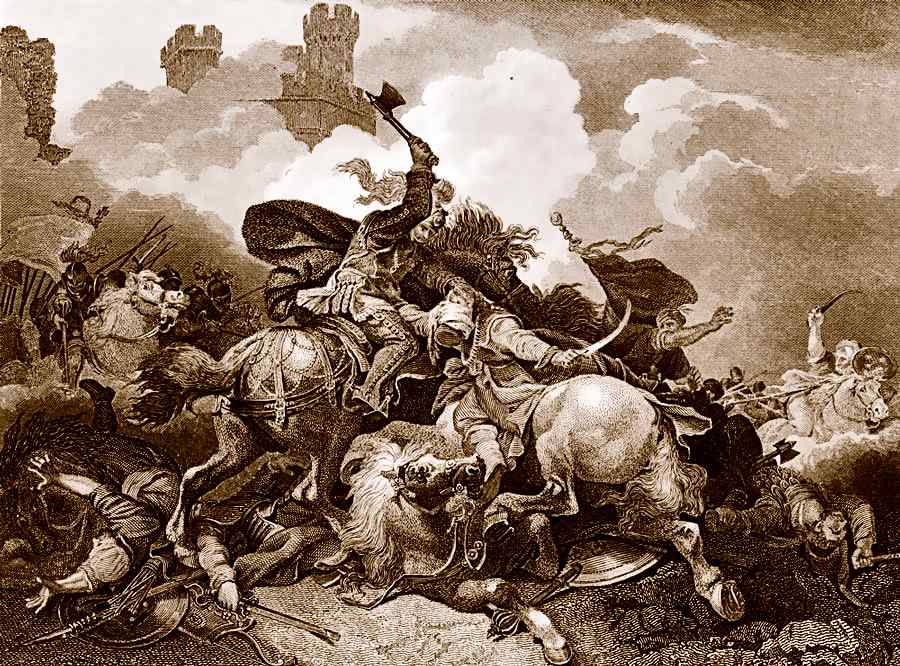 |
|
Richard the Lionheart - Wields Battle Axe |
| Salah al-Din spoke of the 'Warrior King Richard' - "If I
should be fated to lose the Holy Land, I would rather lose it to Malik
Ric than to any other." Salah al-Din admired the Lion Hearts courage,
while perceiving his inability as a strategist. The Third Crusade was
over. |
| Conrad Lord of Tyre, the Marquis of
Montserrat, a near relation of Leopold, Duke of Austria, had been
murdered by two Hashishians, said to have been hired for that purpose by
King Richard I of England. The imprisonment of Richard the Lionheart as
he was returning home from the Crusade, by Leopold of
Austria, was in reprisal for this murder of his kinsman.
October 9th, 1192 - Richard the Lionheart took ship. He sailed on a
galley with a small escort. His brother John was by now well settled in
England and nearly every reigning prince of Europe his enemy. He tried
to pass through German lands in disguise but was recognized by his
royal bearing. He was taken by Leopold of Austria, the Emperor, and held
for ransom. The entire "Robin Hood" legend is based upon
these events. In the tale, it is only when the King Richard returns to
England and deposes his brother that all is well again in merry old
England. |
|
Salah al-Din
Crosses Swords with the Hashishians (Assassins) |
| The Assassins were as birds of prey, perched in their rocky
eyries, watching the movements of human beings in the crowded valleys
below. No one knew in what place the shadow of this predator's wings
would fall, though they were most often seen in the mountain region of
Persia far to the east, and in the hills north of Lebanon. This terrain
also acted as a physical divider between the Crusaders and the Moslems.
During the chaotic conditions of the last hundred years the Assassins
had risen to the height of their power. They were however by no means
supreme. Sultan Salah al-Din, without meaning to do so, nevertheless roused against
himself a dangerous and diabolical enemy. During his campaign to clear
out the underworld in Cairo, Salah al-Din destroyed the lodge of the
Ismailite Sect, the 'Free-thinkers' who acknowledged the authority of no
sultan.
Ismailites stirred up the Sudan nomads into revolt. Salah al-Din
scattered the rebels and crucified the leaders, nailing them to the city
gates. This brought down upon him the anger of the Ismailites
(Assassins). Now the secret order set about to slay him in their own
unique manner. |
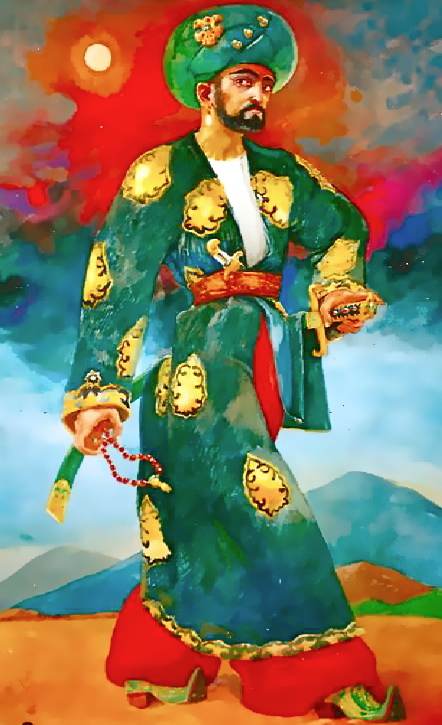 |
The Grandmaster of the Ismailite order in Syria was one Ruckn
ad-Din. It was said of him that he never left the walls of Castle
Massaif by day, and that he had the power of going and coming
through any obstacle. His followers believed he was more God than man,
since he had never been known to eat, drink or sleep. The Hashishians first attempt to murder Salah al-Din failed, because of
the vigilance of his personal guards. The Sultan went on his way
undisturbed.
It was his custom to bar no one from his tent, and Salah al-Din greeted
everyone with grave courtesy and asked what gift they would have from
him. Sitting alone in his tent he was visited by three Assassins. They
gained the tent and flung themselves at him. The rearmost of the three
was swept from his feet by the sword of an outer guard. The Sultan
warded off the dagger of the first and moved aside. A knife blade struck
against the steel of his headpiece, wounding him slightly. Before the
fanatical youths could deal a deadlier strike, the bodyguards were upon
them from behind. Thrown down and disarmed, they were carried off to be
tortured into confession and then hewn apart.
They were sent, his captains informed him, "by the Shaikh al Jebal".
This second attack upon his person was just too much for the patience of
Salah al-Din or for that matter the endurance of his officers. The
entire army was mustered in ranks. Then the army saddled up and marched
up into the mountains of the Hashishians, between the long valley of
Hamah and the sea.
Here in the pine darkened uplands the half-wild cattle grazed among the
sandstone ledges, and isolated on the summits, the castles of the Shaikh
loomed against the clouds. Salah al-Din's horsemen ravished the valleys
thoroughly, driving off the cattle. They then made their way to the
yellow castle called 'Massiaf'; rising from an outcropping of solid
rocks with its sixty-foot walls, it was the impregnable stronghold of
the Assassins in Syria. The great stones of the castle, fitted together
without cement on the elevation of the rock, defied the Sultan's siege
engines for a week.
Then it was that Salah al Din awakened to find a dagger thrust into
the earth near him, and a scroll bearing a message.
"That thou possesses shall escape thee in the end, and return to Us."
"Know that We hold thee, and will keep thee until the account be
closed." |
| Salah al Din's guards then surrounded his pavilion at night with a
solid ring of men, and scattered flour outside the tent cloth. On the
following morning the Sultan was unharmed and no human visitor had been
seen. But in the white flour lay tracks of feet entering and leaving the
tent. They were footprints that pointed outward, both coming and going. |
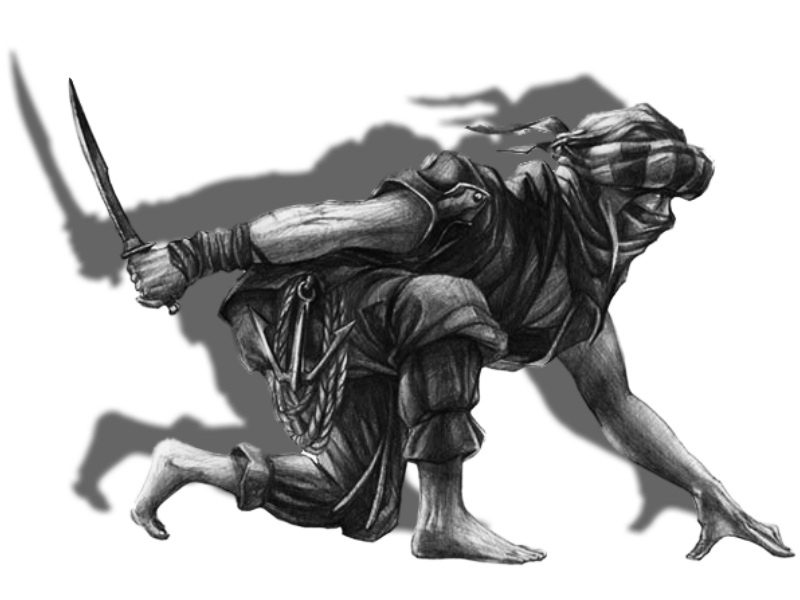 |
By this time the Sultan's officers were in a mood that verged upon
homicide and panic at once. They were not reassured by a message sent
down from the battlements of Massiaf in quite an earthly manner, by a
paper tied to an arrow.
"Knowest thou not that We go forth and return as before, and by no means
mayest thou hinder Us."
After this few slept the night in peace within the lines of the Sultan's
army. True to his promise, they beheld the Grandmaster of Massiaf depart
from the castle in the night, through all of them!
The chronicles speak of a blue light which glowed upon the dark
battlements and descended to the rock, fading and springing up anew in
another place. Arrows were shot at it, and torches swung in vain. Like a
dancing will'-o'-the-wisp, the strange blue light darted among the army
and vanished at last toward the hills.
Then the Grandmaster pledged Salah al Din immunity from the weapons of
the Assassins, and the Sultan withdrew from Massiaf at the end of the
week. Thereafter, the "Men of the Mountain" did not molest Salah al Din,
nor did he ever again invade their country, or assault their fortresses. |
|
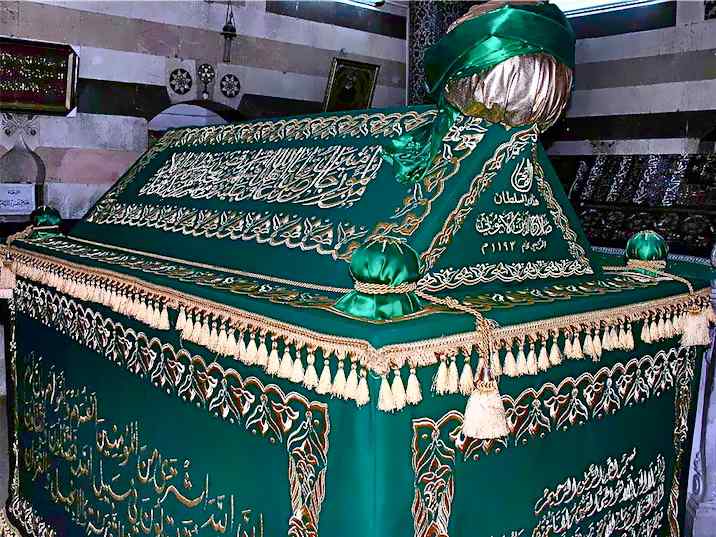 |
|
The Coffin of Salah al-Din |
March 3rd, 1193 - Death of Salah al-Din which led Pope Innocent III
to inaugurate the Fourth Crusade. But the Crusaders could not defeat the
empire that Salah al-Din had established. Even worse, this Crusade
unleashed Christian against Christian in a barbaric display.
Sala al-Din's reputation for generosity, religiosity, and commitment to
the higher principles of a 'Holy War' have been idealized by Moslem
sources and by many Westerners including Dante, who placed him as a
ďVirtuous Pagan.Ē
Sala al-Din obeyed literally the law of Islam; he gave his possessions
to those who served him and he fought for the faith. His spoken word was
inviolate, in all circumstances. When he died at the age of 55 from
yellow fever he had given his wealth to charity, except for one gold
piece and forty-seven pieces of silver. |
|
Knights Templar at Constantinople (4th Crusade) |
Knights Templar with King Richard (3rd Crusade) |
| In 1202-1204 - There can hardly have been a worse event in the Middle Ages than the
sacking of the great city of Constantinople by a crusader army. It was a
Christian army destroying a Christian city. The scars of that incident
can still be seen in modern Istanbul in the remains of Byzantine
monuments stripped of their gold and jewels and left as naked stone.
There were even more Crusades. They were less and less effective in
regards to liberating Jerusalem, and are beyond the scope of this
historical. The Crusades are a subject deserving an entire section of
its own. It is a vast subject which we have only glancingly covered
here. Many a great warrior on both sides can be drawn forth from
these conflicts. |
|
One Hundred Years after the Third
Crusade
Acre is still the Pivotal Point in the Holy Land |
| Jerusalem remained (except for a short period), under Moslem rule,
thus immeasurably increasing the importance of Acre, which, during the
13th century, served as the political and administrative capital of the
Christians. Acre was the Crusadersí foothold in the Holy Land, a mighty
fortress facing constant Moslem threat. Its port served as the Crusader
Kingdomís link with Christian Europe, and also for trans-shipment
westward of valuable cargoes originating in the East. It is a curious
turn, in the tide of events, at the time: that Princes of Christiandom
were no longer in sympathy with the Crusades, but were instead involved
in their own personal quarrels and achievements, while a Mongol Warlord
prepared to enter the Holy Land and take Jerusalem, in the face of the
Moslem power.
Baibars - Fourth Mameluk Sultan of Egypt, heard the rumble of the
Mongol Juggernaut from afar and prepared to ward off catastrophe. Baibars had been intensely occupied in routing the Assassins
(Hashishians) out of their Citadels on the peaks, north of the Krak. One
by one he had mastered the summits of the dark hills in which they had
lived isolated for so long. |
|
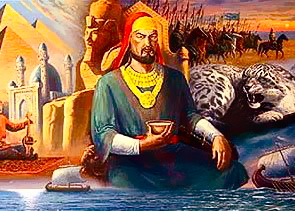 |
Baibars kept the invading Mongol Horde
from his Empire and organized his state and army to endure. His
successor, Al Mansur Qalawun, took over a strong military state. Baibars
imposed upon Qalawun the duty of driving the Crusaders from their last
strongholds. The Holy War (Jihad), must be fought to the end. Autumn 1281
- Mongol Khan Abaqa set his army in motion
towards Jerusalem. The Christian Georgians joined the standard of the
Horde. The Armenians flocked down and the Knights rode from Marghab to
swell the armed forces of the Khan. Thirty thousand Christians marched
with the Mongols down the Valley of Hamah.
Upon the wide plain by the small Lake of Homs, the Egyptian host gave
battle to the invaders. For the first time the Mameluks were face to
face with the full army of the Mongol Khan and his allies. The battle
was sudden and devastating. |
|
The cavalry divisions of the Mongols and the cavalry
divisions of the Mameluks scattered over the plain in charges that
carried the forces leagues in distance. The right wing of the Mongol
Horde crushed everything before it, while Qalawun with his 'Halka' held
firm in the center.
At the end of the day, Qalawun and his Mameluks still
held the field. The Mongol horsemen had been split into two forces. The
Mongols rode off on the Moslem horses, which they preferred to their
own. The Christians; Armenians and Georgians, being mostly infantry,
were left stranded by themselves. The Christian forces were nearly
annihilated in the long retreat on foot toward the mountains in the
north.
As Baibars had done, Qalawun had beaten off the Mongol
attack, and in the following years he avenged himself on the Knights of
Marghab, and Tripoli, for their alliance with the Mongol invaders. |
|
Marghab - Massive Crusader Castle |
With irresistible numbers Qalawun isolated and laid siege to Marghab.
He forced his way up the steep mountain until he could pound with his
siege engines at the massive black walls. For thirty-eight days the
engines beat at the basalt walls. Marghab was cut off, without hope of
aid, and the Master of the Knights Hospitalers surrendered the castle.
Four years later Tripoli fell to Qalawun's attack. Upon the violent death of Bohemund VII,
at Tripoli, the line of the Norman Princes of Antioch ceased, after a
reign of close to two hundred years. |
|
Only Acre Remained under the
Christians
(Except for some small seaports) |
Qalawun ordered the timbers cut for the siege engines, and the
sledges of rocks started on the road down from the hills, toward the
last Christian fortress city, Acre. Then the Sultan's litter was laid on
the ground and he died. But not before he gave the command that he
should not be placed in his tomb until the unbelievers had been driven
from Acre.
His son, El Malik el Khalil, took the reins of command, ordering the
march resumed.March 1291 - The remnants of the Crusaders
filled the walls of Acre, and thronged the gardens of the suburbs. Most
had journeyed from the hill castles, bringing what goods they could
carry with them. At Acre was the Prince of Galilee and the Lords of
Outremer.
In the streets of Acre rode the Templars and Knights Hospitalers who had
all been driven from their castles. Galleons crowded the port, coming
and going from Cyprus. But there were not enough of them to evacuate the
city if need be. The taverns were thronged. So the Crusaders gambled and
feasted to drown the suspense and gnawing fear. |
|
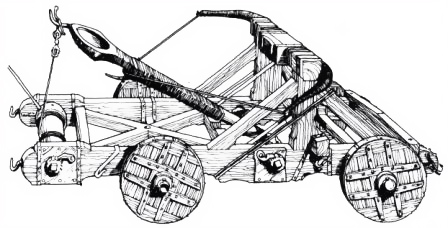 |
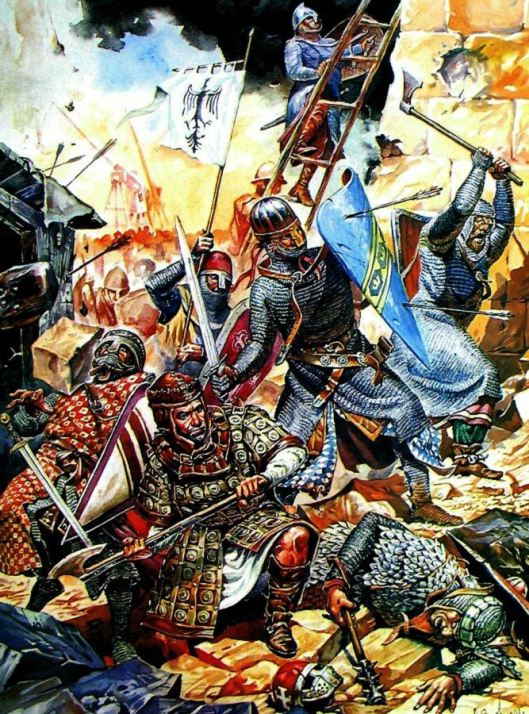 |
Acre was Conquered on May 18th, 1291
(End of the Crusader Presence in the Holy Land)
After two weeks of intense siege, with the thudding of
fore-score siege engines, the cracking of boulders against crumbling
walls, the flash and roar of exploding Naphtha, and the ceaseless
summons of the drums. The drums carried on Camelback, scores of them,
that dinned and thundered continuously through the hours.
Through the gardens of the suburbs, and over the smoking ruins of
outlying palaces, surged the host of Islam. Finally, the wall was
breached by fully sixty yards, the moat filled in by columns of beasts
of burden, driven forward laden with incendiaries, and slaughtered at
the ditch. The weary Crusader warriors, holding the breach, blinded by
the smoke, awaited the assault.
The Templar Knights had already regained the breach after one deadly
onset, but there was no one to relieve them. They waited and listened to
the diapason of the drums, and the songs of the Dervishes beyond the
smoke.
Through the night the men of Islam made ready, mustering
in four waves. The first wave carrying heavy wooden shields, the second
cauldrons of oil and torches, the third bows, the fourth short, curved
swords. Behind these came the regiments of horsemen. In the half light
before dawn, passed the white-robed Dervishes carrying long knives, they
would lead the way. The Dervishes sang that Allah had shrouded them with
a mantle. For a heavy mist lay along the shore and upon the line of the
wall, and the sea had risen, so that it barred flight, tossing the
Crusader ships in its grip.
The drums pounded their summons, and the cymbals clanged. The Dervishes
began to scream and run through the mist. After them advanced the first
wave of the attack. The clatter of steel was drowned out against the
monotone of the drums. The defenders were overwhelmed and driven from
the breach.
When the Sun broke the mist, the Moslems were within the
wall. |
| Then the tumult, that had died down, sprang up anew. The Grandmaster
of the Knights of the Hospital of St. John, with his full contingent of
Knights, charged the Moslem waves and threw back the attack. Then,
with a measured tread, the armored regiments of Mameluks advanced, over
the ruined moat, over the piles of bodies and the broken engines,
pressing back the wounded Knights, forcing their way into the streets,
surging around groups of Christians trying to beat them off. Behind the
Mameluks, the Moslem cavalry rode into Acre.
The drums ceased. Essentially Acre had fallen. But for hours
the Crusaders fought, individually and in numbers. By nightfall of this
day, Malik el Khalil controls the entire city of Acre except for the
Templar Temple/Fortress on the shore. |
|
Acre . . . circa 1291 |
The Last Stand at Acre |
The surviving Templars held out in their fortified headquarters by
the sea. A large number of women and children had fled to them for
protection and the Templars put as many refugees as possible aboard the
Order's galleys, sending them off to join the fleet. They waited until
the last boats had made it to sea or were captured. Then the Knights
Templar surrendered and were disarmed.
The Moslems swarmed into the great fortress, tearing the garments from
young girls. Then the Templars, with their bare hands, turned on the
despoilers and slew them. Closing the doors against the Moslems outside,
they defended their house for an additional ten days of conflict.
Finally, fire and steel overcame them. Part of the massive wall
collapsed and 2,000 Mameluk troops poured in to meet a bloody reception.
The weight was too much for the tottering building, which came crashing
down and Moslems and Templars perished together in a flaming finish. It
was the end.
By mounted courier and pigeon post the tidings spread through the
Islamic world. Thirty thousand "Franks" had fallen to the sword in a
single day at Acre. The bodies of the Templars had burned in their black
towers. Mighty Acre had fallen! |
|
 |
|
Friday the Thirteenth and the
Knights Templar |
Jerusalem is long since under the control of Moslems and the validity
of the original purpose of the Templar Order is in question.
Yet the Templars are a wealthy and powerful money lending institution,
even to the nobility, and even to Kings, who must finance their wars. |
|
Friday - October 13th, 1307
An Infamous Day
Why "Friday the 13th" become an Omen for Unlucky
Fortunes |
|
King Philip IV of France |
Nefarious Scheme of the French King |
| In the 12th and 13th centuries, the chief instruments of
foreign exchange were the two great military orders, the Knights Templar
and the Knights Hospittalers. They held large properties in every part
of Europe and in foreign countries, and the fact that they combined
religious sanctity with military power made everything in their
possession particularly safe. They accepted money in one country and
paid it out in another. To put it bluntly, King Philip IV of France, called the "Fair" for
his pretty looks, not for his immoral character, refused to pay his king
sized bills. Therein lies the story of bad luck Friday the 13th.
The French King Phillip IV hated the Knights Templar because they
were so rich and powerful. But mostly because he owed the Templars too
much money and needed even more gold to fund his war with England. So
Phillip made plans to crush the Templars and take their wealth. He set
up a corrupt Pope in Avignon, France, instead of Rome, in order to
control the Pontiff as his puppet. Friday, October 13, 1307 -
King Philip IV seized the Temple in Paris and on the same night,
ordered the arrest of every Templar in France. The Templar Grand Master
Jacques de Molay and countless other French Templars; knights,
sergeants, priests, and serving brethren, were simultaneously arrested,
placed in chains, and charged with heresy, blasphemy and various
obscenities. The arrest warrants started with the phrase "God is not
pleased. We have enemies of the faith in the kingdom." They were accused
of every crime the medieval mind could imagine! The charges included
apostasy, idolatry, sorcery, obscene rituals and homosexuality,
financial corruption and fraud, secrecy, even concealment of the "Holy
Grail". Pope Clement V, was also perpetually short of cash, and he was
persuaded by King Philip IV to authorize the trials of the Templars.
Pope Clement V primarily owed his position to King Philip's influence.
After more bullying from King Philip IV, Pope Clement V then issued the
papal bull 'Pastoralis Praeeminentiae' on November 22, 1307, which
instructed all Christian monarchs in Europe to arrest all Templars and
seize their assets. |
|
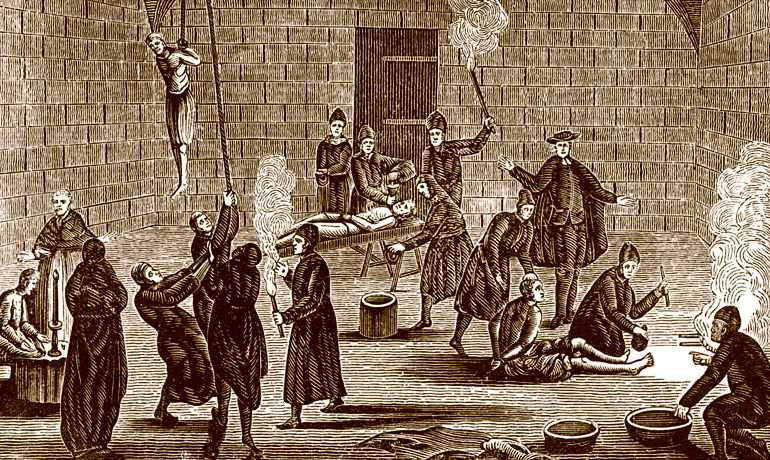 |
|
Confessions Tortured from the Knights Templar |
No evidence was needed for proof. Confession was enough and it was
readily obtained through torture. The Templars, many of them old men,
were racked, thumb-screwed, starved, hung with weights until joints were
dislocated, had teeth and finger nails extracted one by one, bones
broken by wedges and feet held over flames. A pause followed each pain
for the admission of guilt. One chronicler acknowledged they "would have
confessed they had slain God if they were asked that."
Either way they were damned, for confession meant death at the stake,
burned alive.
These confessions, even though obtained under coercion of torture,
caused a scandal in Paris. All interrogations were recorded on a thirty
meter long parchment, kept at the "Archives Nationales" in Paris. The
parchment mentions a red, monochromatic image of a man on linen or
cotton, qualified as an idol by the interrogators. This suggests the
presence of the Shroud of Turin.
In 1307 few people knew of the Shroud's whereabouts. After the sack of
Constantinople by the Fourth Crusade in 1204, the Shroud, that had been
in the possession of the Emperor, disappeared for over a century. The
Shroud reappeared in the small town of Lirey, in the Champagne region of
France around the years 1353 to 1357.Pope Clement V called for papal
hearings to determine the Templars guilt or innocence, and once freed of
the torture, many Templars recanted their confessions. But in 1310
Philip IV blocked this attempt, using the previously forced confessions
to have dozens of Templars burned at the stake in Paris.
With Philip IV threatening military action unless the Pope complied with
his wishes, Pope Clement V finally agreed to disband the Templar Order,
citing the public scandal that had been generated by the confessions,
though obtained under torture.
In 1312 Council of Vienne - Pope Clement V issued a
series of 'Papal Bulls', which officially dissolved the Knights Templar
Order and turned over most Templar assets to the Knights Hospitalers. |
|
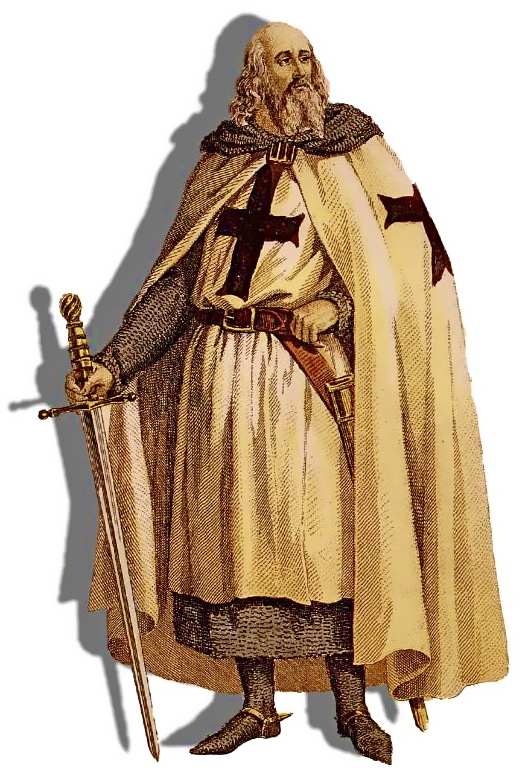 |
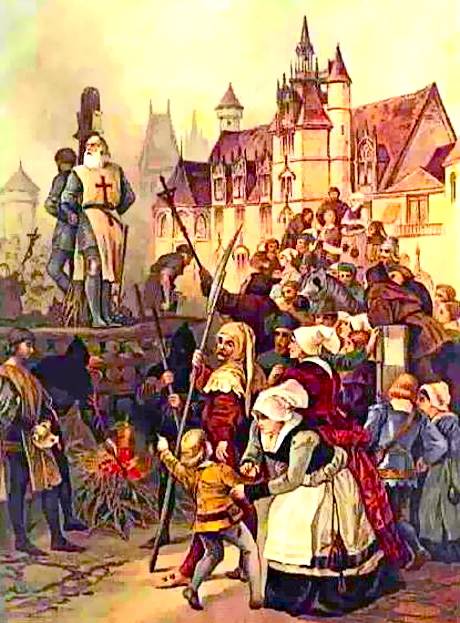 |
|
Jacques de Molay |
Execution of Jacques de Molay |
| Grand Master Jacques de Molay who had confessed under
torture, languished in prison for 7 years. He was given a life sentence
in 1314. Seeing the destruction of the Templar Order he rose up and
recanted his confession in an act of defiance to King Phillip IV. De
Molay was then declared guilty of being a relapsed heretic, and was
sentenced to burn alive at the stake in Paris, on March 18th, 1314.
The Templars had been systematically hunted down and exterminated until
the last Grand Master, Jacques de Molay was burned at the stake, taking
with him the occult authority of the Templar secret society.
De Molay remained defiant to the end, asking to be tied in such a way
that he could face the Notre Dame Cathedral and hold his hands together
in prayer.
According to legend - De Moley called out from the flames that
both Pope Clement and King Philip would soon meet him before God. His
actual words were recorded on the parchment as follows "God knows who is
wrong and has sinned. Soon a calamity will occur to those who have
condemned us to death".
Pope Clement V died only a month later, and King Philip IV, who ordered
the capture, persecution and death of the Knights Templar, died
mysteriously in a hunting accident before the end of the year.
The last of the Templar Order's leaders were gone. Many Templar
Knights eluded persecution and were absorbed into other military orders
such as the Knights Hospitaller and the Knights of Malta, or were
pensioned and allowed to live out their days peacefully.
Some may have fled to other territories outside Papal control, such as
excommunicated Scotland or to Switzerland. Templar organizations in
Portugal simply changed their name, from Knights Templar to Knights of
Christ.
At this time the Knights Templar disappeared from history into the
shadowy unknown realm of legend and myth. |
|
The Chinon Parchment - Absolves the
Templar Order |
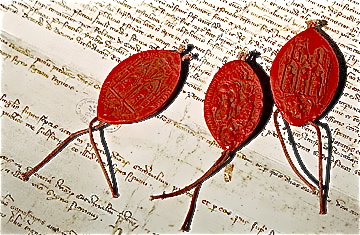 |
In 2001 - A researcher found a document in the Secret
Vatican Archives called the Chinon Parchment, which proved that Pope
Clement V absolved all the members of the Knights Templar of charges of
heresy in 1308, and only issued his Papal bull of suppression for the
Order because of political pressure from King Philip and the threat of
scandal.
These Vatican documents, which have come to light in the Secret
Archives, showing that the unprecedented global massacre of the Knights
Templar in the Middle Ages for alleged heresy, idolatry and sexual
perversion, continued even though the Pope had exonerated them in a
secret trial.
Because of this, the official Vatican viewpoint on the
Order of the Knights Templar in modern times is that they were wrongly
persecuted and innocent of the charges against them. |
|
A Replica of the Minutes of Trials
in which Pope Clement V Absolved the Knights Templar of Heresy in 1308 |
These secret documents had been apparently "misplaced" since around
1628. |
|
Masonic Knights Templar . . . circa 19th Century |
| The Order of Knights Templar - Today exists as the top
ranking Masonic organization in the York Rite of Freemasonry. The
Templar Order today requires membership in a Chapter of Royal Arch
Masons and in some jurisdictions, membership in a Council of Royal and
Select Masters. |
|
Knights Templar Caves
Under Shropshire Field |
It might look like an unassuming rabbit hole, but the tunnel leads
to a stunning network of caves dating back 700 years.
The caves are hidden less than a meter beneath a farmerís field in
Shropshire, England and were used by followers of the Knights Templar, a
medieval religious order that fought in the Crusades.
Much is made of the bravery and purity of the knights, who protected
Christian pilgrims in the Holy Land.
The Order was founded at the height of the Dark Ages and was given space
on the Temple Mount above the ruins of King Solomonís Temple in
Jerusalem.
The order attracted new members from all over Europe, before it was
disbanded by Pope Clement V, in 1312.
Some people continue to believe the knights simply went underground and
to this day harbor a secret that could topple the Catholic Church.
Considering how long itís been there itís in amazing condition, itís
like an underground temple.The tunnel leads to a network of walkways and
beautifully carved arches.
The cave was quite cramped and those nearing six feet tall would have to
bend down to fit in.
|
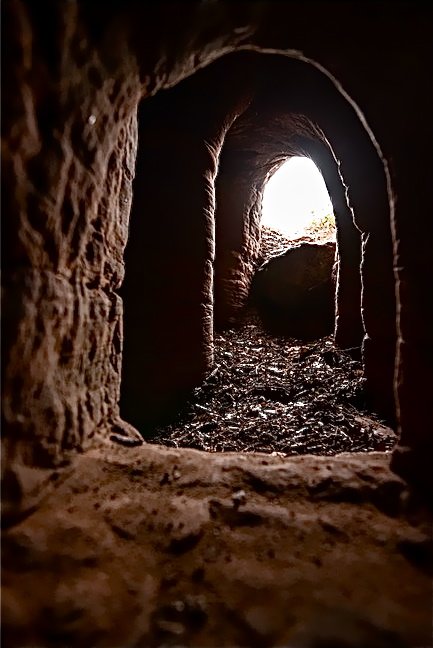 |
|
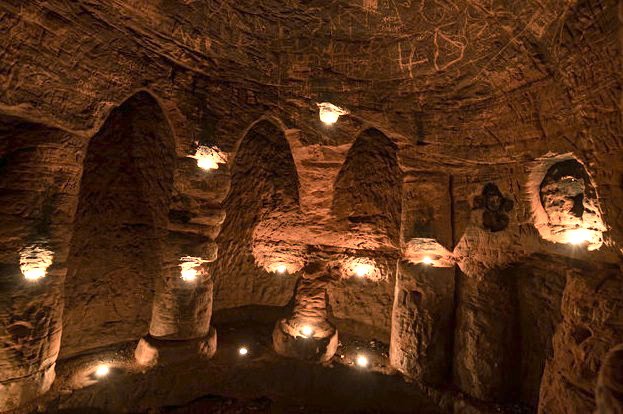 |
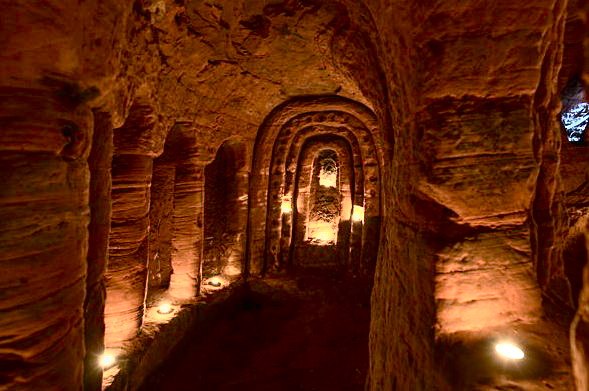 |
|
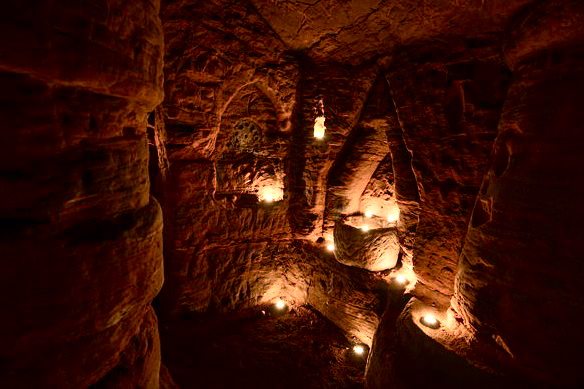 |
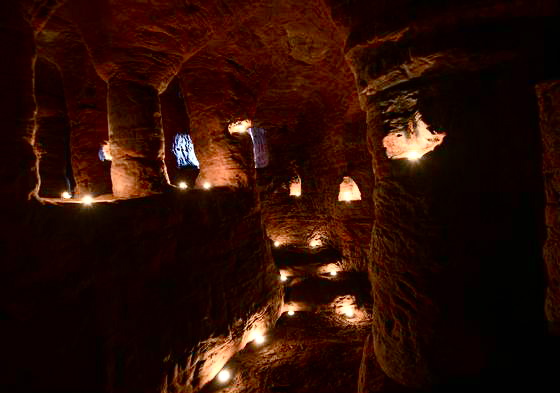 |
|
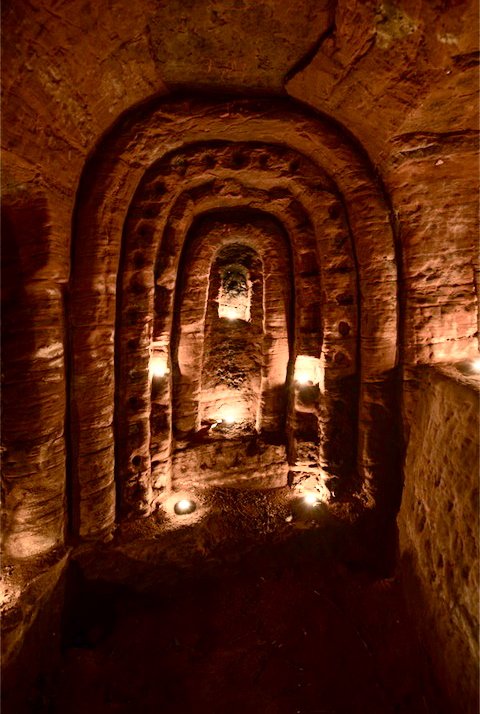 |
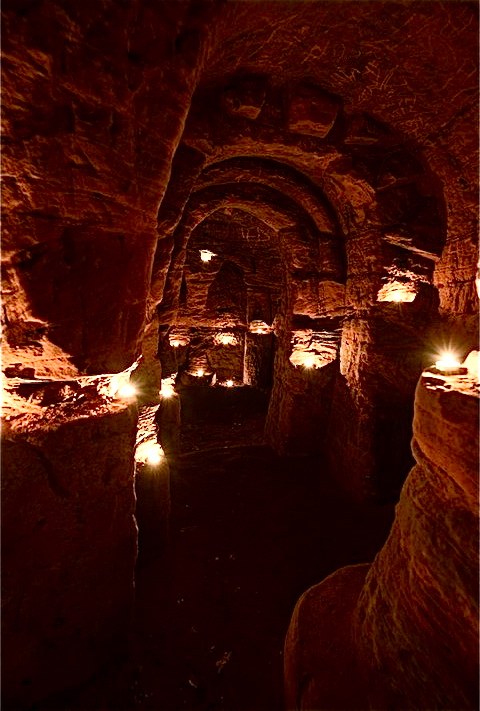 |
|
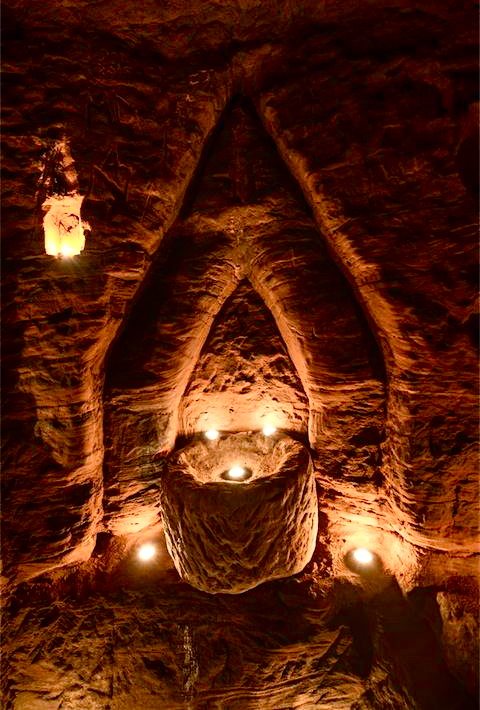 |
|
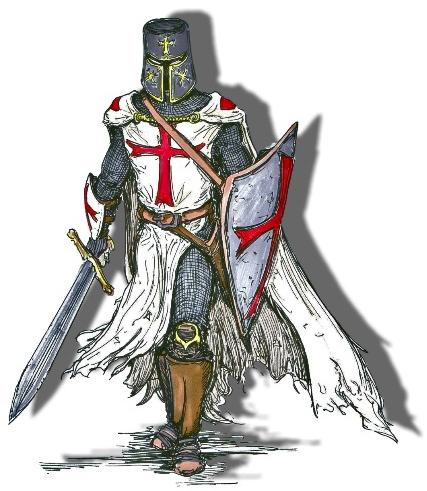 |
|
|
 |
|
The Knights of St John are the
worlds oldest Knighthood and the worlds third oldest Religious Order
The most important of all the military orders, both for the extent of
its area and for its duration. It is said to have existed before the
Crusades and is not extinct at the present time. During this long career
it has not always borne the same name. Known as Hospitallers of
Jerusalem until 1309, the members were called Knights of Rhodes from
1309 till 1522, and have been called Knights of Malta since 1530. The
Knights of Malta are the militia of the Pope, and are sworn to total
obedience by a blood oath which is taken extremely seriously and to the
death. The Pope as the head of the Vatican is also the head of a foreign
national power. |
|
From the days of the Great Siege
Helmet . . . circa 1535 |
Skull of Gerard Sasso
Founder of the Order of St. John of Jerusalem |
From the days of the Great Siege
Helmet . . . circa 1535 |
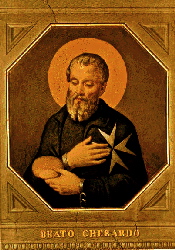 |
The Origins of the Order - Which is
known as the Knights Hospitaller of Saint John of Jerusalem, of Rhodes,
and of Malta, dates back to around 1050 when the Republic of Amalfi
obtained permission from Caliph Ali az-Zahir of Egypt to build a hospice
in Jerusalem along with a church and convent to offer treatment and care
to pilgrims of any faith or race. The hospice was built on the site of
the monastery of Saint John the Baptist and was served by Benedictine
brothers.
Following the First Crusade, and under the guidance of its founder, the
Benedictine Monk Blessed Gerard of Ridefort, the establishment of the
Hospital and its Order was approved by a Papal Bull issued by Pope
Paschal II in 1113. Placed under the aegis of the Holy See, the
community (now known as The Order of Saint John of Jerusalem) had the
right to freely elect its superiors without any interference by other
secular or religious authorities.
The Hospitalers in order to protect the pilgrims had to fight the
infidels and when this gradually became of greater importance than
healing, it resulted in the Order's members becoming also Soldiers of
Christ. The "Knights" themselves who had military duties never exceeded
six hundred in number and had to be of noble birth from both parents and
bound by the monastic vows of Charity, Obedience and Poverty. |
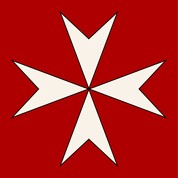 |
The Eight Pointed Cross, later known as
the Maltese Cross was worn on the black monastic habit of the Hospitaller Brothers as a symbol of Jesusí crucifixion. The first cross
was made of white material symbolizing purity, and had long arms with
slightly split ends as was common in depictions of crucifixes in the
12th and 13th centuries. The Order was governed by its Grand Master
and the Council. It also minted its own money. The Order remains a Catholic organization which claims sovereignty
under international law and has been granted permanent observer status
at the United Nations. |
|
 |
| The Grand Masterís Palace has been the administrative centre
of Malta for almost three and a half centuries. The original palace,
built in 1571, was the seat of the Grand Master of the Knights
Hospitalliers of St John and later, during the British colonial period,
served as the Governorís Palace. Today it is home to the House of
Representatives of Malta and the office of the President of the Republic
of Malta. |
|
The Grandmaster's Palace and Courtyard in Malta |
Lion in Courtyard |
|
Grandmaster Palace's Magnificent Interior |
|
Granmaster's Palace Armoury |
|
Helmets from the
'Great Siege of Malta' (1565) |
|
Jannisary Axe
Jannisaries Military Division of the Turkish Army (14th century) |
|
Gonne Shield |
Grandmaster De
Vallette - Breastplate |
| Gonne Shield: Thought to be part of the
gift of arms sent by King Henry VIII to the Order of St. John in 1530.
Such a shield was armed with a pistol which protruded from a hole in its
middle. The aim behind this weapon was that it could be both an
offensive and a defensive device. |
|
Ancient Maltese Parade Armor |
|
Parade Armor of Grandmaster Alof de Wignacourt |
Child Parade Armor |
|
Over 450 Years Ago - 1565 |
|
 |
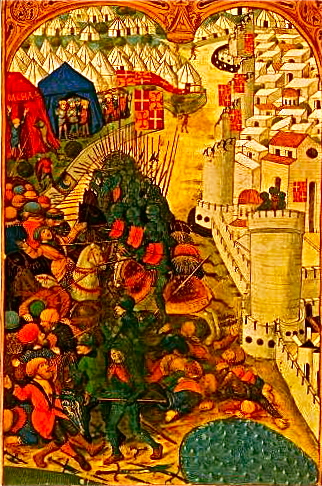
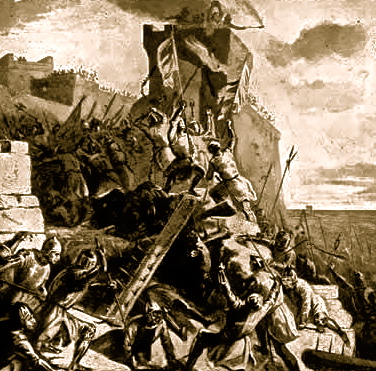 |
Historical Perspective
In 1291, Acre, the last Christian stronghold in the Holy Land, was lost
when the Egyptian army routed the Christian forces. The Knights who
survived sailed to Cyprus to regroup their forces. Fast becoming
entangled in the kingdomís politics, the Order set its sights on the
island of Rhodes as its new home. In 1309 they captured
Rhodes after overcoming the inhabitants' heroic resistance. In 1310, Grand Master Fulkes de
Villaret completed a successful two year campaign to capture the
territory as well as a number of neighboring islands. Their years at Rhodes were
the most brilliant of their history.
To survive the constant threats of Barbary pirates, the Egyptians and
the Ottoman forces, the Order was forced to become even more of a
military organization and created a powerful naval fleet. At Rhodes they
established themselves as a great naval force and were a vigorous and
belligerent outpost of Western Christendom. This most
important change in the character of the order was a transformation of
the knights into corsairs. The piracy practiced by the Muslims was the
scourge of the Mediterranean and especially of Christian commerce. The
Knights of Rhodes, on their side, armed cruisers not only to give chase
to the pirates, but to make reprisals on the Turkish merchantmen. With
increasing audacity they made descents on the coast and pillaged the
richest ports of the Orient, such as Smyrna (1341) and Alexandria (1365)
In 1522, an invading armada of 400 ships under the command of Sultan
Suleiman descended upon the Order in Rhodes. Against a force of 200,000
Ottomans, the Knights, under Grand Master Philippe Villiers de L'Isle-Adam,
had about 7,000 men-at-arms. Six months of siege ended with the brave
Knights finally surrendering. The survivors were allowed to leave Rhodes
with military honors, so they retreated to Sicily in 1523.
The Order had lost its territory and spent 7 years moving from place to
place throughout Europe until, in 1530, the Holy Roman Emperor, King
Charles V of Spain, gave the Knights the Maltese Islands and the North
African port of Tripoli as fief, under the overlordship of the Spanish
Viceroy of Sicily. The annual fee for the island was a single Maltese
falcon.
From their new base and small number of ships, the Knights were soon
proving to be a thorn in the side of the Ottomans once again. It wasnít
long before Suleiman gathered another massive invasion force of about
48,000 men, including some of his elite warriors. In 1565, the Turks
invaded Malta. What became known as The Great Siege of Malta resulted in
one of the greatest victories in history for an undermanned and vastly
outnumbered defense force. Under the inspired leadership of Grand Master
Jean Parisot de la Valette, 700 Knights, 2,000 professional soldiers and
3,000 militia drafted in from the Maltese population and a handful of
servants and slaves fought valiantly for three months until victory was
secured.
Also in the year 1565, following the Great Siege, it seems that the
Knights vowed to turn Malta into a fortress that befitted a military
Order. Because of the critical financial difficulties following Malta's
Great Siege by Turks against the Knights, and to have funds to pay the
several thousand laborers engaged in the building of the new city of
Valletta, the Order found it expedient to strike fiduciary copper coins.
The foundation stone was laid by La Valette for the city which would
bear his name, and pride of place in the centre of the city was reserved
for St Johnís, the Church of the Order. The fleet of the Order, becoming
one of the most powerful in the Mediterranean region, contributed to the
ultimate destruction of the Ottoman naval power in the battle of Lepanto
in 1571. |
|
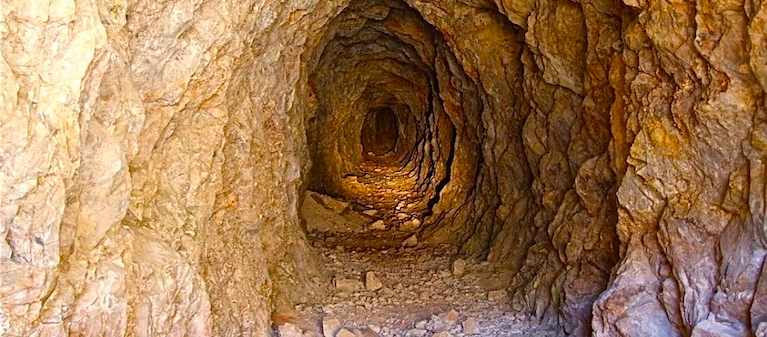 |
|
Hostile Tunnels Discovered by the Knights of St.
John of Malta in 1565 |
|
Great Siege of Malta - "Death of Dragut" by
Giuseppe Cali (painting) |
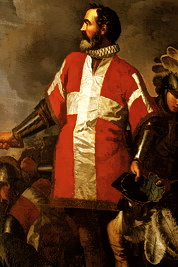
Grand Master
Jean Parisot De La Vallette
(1557-1568) |
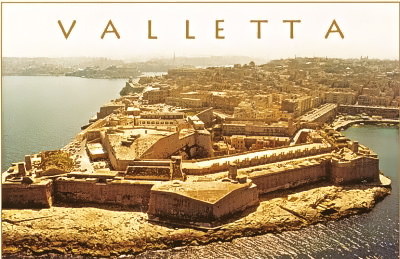 |
History of Valletta - Malta
Valletta owes its existence to the Knights of St John, who planned the
city as a refuge to care for injured soldiers and pilgrims during the
Crusades in the 16th century. Until the arrival of the Knights, Mount
Sceberras, on which Valletta stands, lying between two natural harbors,
was an arid tongue of land.
No building stood on its bare rocks except for a small watch tower,
called St Elmo, to be found at its extreme end. Grand Master La Valette,
the gallant hero of the Great Siege of 1565, soon realized that if the
Order was to maintain its hold on Malta, it had to provide adequate
defenses. Therefore, he drew up a plan for a new fortified city on the
Sceberras peninsula.
Pope Pius V and Philip II of Spain showed interest in the project. They
both promised financial aid and the Pope lent the Knights the services
of Francesco Laparelli, a military engineer, who drew up the necessary
plans for the new city and its defenses. Work started in earnest in
March 1566 - first on the bastions and, soon after, on the more
important buildings. The new city was to be called Valletta in honor of
La Valette.
The Grand Master didnít live to see its completion and he died in 1568.
His successor, Pietro del Monte continued with the work at the same
pace. By 1571, the Knights transferred their quarters from Vittoriosa (Birgu)
to their new capital. Architect Laparelli left Malta in 1570. He was
replaced by his assistant Gerolamo Cassar, who had spent some months in
Rome, where he had observed the new style of buildings in the Italian
city.
Cassar designed and supervised most of the early buildings, including
the Sacra Infermeria, St John's Church, the Magisterial Palace and the
seven Auberges, or Inns of Residence of the Knights.
By the 16th century, Valletta had grown into a sizeable city. People
from all parts of the island flocked to live within its safe
fortifications especially as Mdina, until then Malta's capital, lost
much of its lure. In the ensuing years, the austere mannerist style of
Cassar's structures gave way to the more lavish palaces and churches
with graceful facades and rich sculptural motifs.
The new city, with its strong bastions and deep moats, became a bulwark
of great strategic importance. Vallettaís street plan is unique and
planned with its defense in mind. Based on a more or less uniform grid,
some of the streets fall steeply as you get closer to the tip of the
peninsula. The stairs in some of the streets do not conform to normal
dimensions since they were constructed in a way so as to allow knights
in heavy armor to be able to climb the steps.
|
|
